Despite the increasing focus on digital marketing in luxury, the virtual has not supplanted the benefits of in-person interactions.
Event marketing provides brands with an opportunity to engage everyone from VIP clientele and celebrities to the public through an experience, taking brand building into the physical world. Whether catering to the interests of a select group or broadcasting a brand story in a public exhibit, these initiatives offer an opportunity to immerse consumers in a brand world through multi-sensory activations.
"Nothing replaces exclusive experiences and access when it comes to building a truly engaged audience," said Shamin Abas, president of Shamin Abas Public Relations, New York.
"While digital connectivity and advanced technology have a critical play in customer experience overall, the real opportunity to ignite deeper relationships with existing clients and expanded reach to new qualified audiences comes from time spent with the key players at a brand in an environment that is reserved for a specially invited few," she said.
Private affairs
A 2014 survey of luxury industry executives conducted by Wealth-X found that 72 percent of respondents identified events as the marketing initiative with the highest ROI. Fifty-eight percent noted an ROI of at least 50 percent for their events.
Two-thirds of those surveyed hold between one and four events a year, looking primarily to grow their client base and engage existing customers (see story).
Invitation-only events offer luxury brands the chance to cherry pick their attendees, gathering a mix or a selection of current and potential clients, famous faces, influencers and media, depending on their goal. For this reason, events are a particularly effective tactic for reaching the ultra-high-net-worth customer, the much sought-after sect with the assets at hand to buy big-ticket items such as planes and yachts.

Shamin Abas PR produced La Bella Machina event for Jet Aviation. Image credit: Jet Aviation
According to a panel discussion at Luxury FirstLook: Strategy 2017, the guest list is often one of the most challenging aspects of throwing an event (see story).
When trying to reach interested buyers, luxury brands are armed with a number of resources for building their guest lists.
While looking at data and demographics can be helpful, marketers should go beyond these points and look at profiles of consumers, investigating whether their passion points will make them a likely strong target for the particular product or brand being promoted.
"Oftentimes, brands bring us in when they have been challenged by their CEO to address ROI on event marketing, and/or have made a decision to not invest any further in events that draw what we call 'the free martini crowd,'" Ms. Abas said. "These are the folks that happily show up for the free drinks and have little potential of being a client of the brand.
"We work with brands to design 'experiences' around specific clients’ interests versus 'having an event,'" she said. "The magic really happens when you have the perfect mix of loyal clients who are vocal about their love for the brand and its people, with prospects."
Another popular profile for invitees is the influencer. These individuals with social media followings numbering in the thousands or millions are desirable attendees due to their power to spread awareness through their networks.
While these social media celebrities can boost awareness, it is important to also vet them for relevancy, as follower count is not as important as their relationship to the brand.
"If you add influencers that are authentic and believable as a fan of the brand, the impact is bigger than using random influencers with high follower numbers and less obvious connection to the brand," said Tapio Pekelharing, managing director and cofounder of Guest, Amsterdam.
For instance, Lancôme invited a group of influencers to the Côte d'Azur on a hunt for Monsieur Big, the imagined character based on the name of a new product line. This destination event provided a backdrop for content that ran on both the beauty brand and influencers’ accounts (see story).
Similarly, jeweler de Grisogono spent a significant share of its marketing budget on a single event during the Cannes Film Festival in 2016. Making good on its investment, the company works with influencers to produce original content (see story).
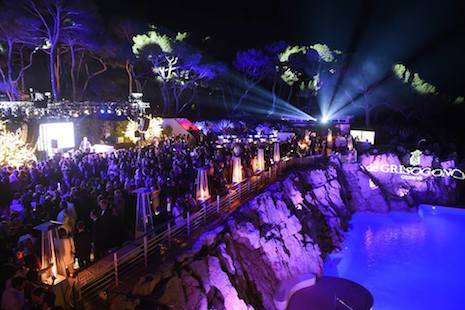
De Grisogono party at Cannes in 2017. Image credit: de Grisogono
Despite the romanticism of far-flung locales, one popular venue for private affairs is a brand’s store, allowing the revelers to peruse or even shop while partying.
Bloomberg noted in 2013 that the store opening is increasingly being attended by not just press, fashion industry personalities and celebrities, but also high-spending clientele as a way to reward their patronage and instill loyalty.
Also working to reward loyalty are automaker-produced driving experiences, which bring owners or affluent fans out to racetracks or the ice to get behind the wheel of vehicles and learn from experts. McLaren's ice-driving experience, for instance, accommodated groups up to 14 at a lodge in Finland for about $15,000 a person (see story).
Similarly, taking intimate to the next level, silversmith Christofle worked with clients to host a series of dinners at its showrooms or private venues. With a table of 10 to 15 guests, the brand was able to educate younger consumers on entertaining in the modern age (see story).
Gaggenau also tapped into the rise in dining and experiences over goods with a pop-up restaurant. The traveling Restaurant 1683 hosted invite-only dinners for influencers from the food, fashion, entertainment and art worlds, transporting them to its home in Germany's Black Forest (see story).
The creation of Gaggenau's Restaurant 1683
Dining and food is a central part of many of Krug’s events, including the Champagne house’s festival, now in its second year. From a private island to the wilderness, Krug invites fans to get away from it all and sample fine cuisine along with its wines in exchange for a ticket price that exceeds the aspirational (see story).
Going public
In addition to performing outreach to potential buyers and the famous, event marketing also has applications for reaching the broader public through ticketed or public events.
Luxury brands frequently reassert their positioning by aligning with events in categories such as sports, entertainment and art.
Affluent pastimes such as golf, equestrian sports and yachting are popular partners in sporting.
For instance, Veuve Clicquot just celebrated the 10th anniversary of its Polo Classic, a ticketed event that includes matches along with entertainment and hospitality (see story).
Lexus has a similar longstanding role with the U.S. Open Championship, with the automaker setting up a stand complete with photo-taking opportunities, meet-and-greets and the chance to try their hand on a golf simulator at the most recent tournament (see story).
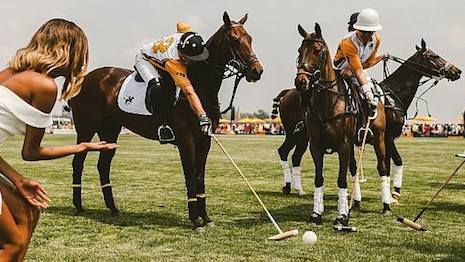
Veuve Clicquot Polo Classic 2017. Image credit: Veuve Clicquot
With sports affiliations common, some brands look outside of the box to present games and competitions that will stand out. Tag Heuer built a floating tennis court in Singapore for a match between Maria Sharapova and Michael Chang (see story).
Brands also take reference from the sports world for events, such as Hublot’s tailgate to celebrate its Hublot Loves Football campaign, which gathered friends of the brand and players on a New York street (see story).
Aside from sports, music and film are also common partners for luxury.
Vying for the millennial audience, Tag Heuer sponsored the Coachella Valley Music & Arts Festival in 2016, while Nordstrom launched a series of pop-up experiences in portable pods at a number of music festivals the same year. The retailer's pods included a screen-printing station, a “dream closet” and a beauty bar, bringing the store to these events (see story).
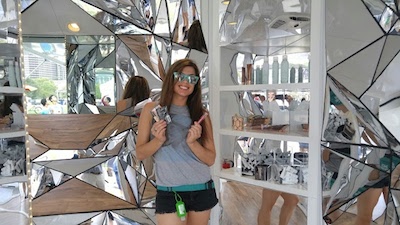
Nordstrom's pods at South by Southwest. Image credit: Nordstrom
Taking it one step further, Gucci hosted its own electronic dance music festival at its headquarters in Milan (see story).
Bringing classical music to the masses, BMW has worked with the London Symphony Orchestra to stage free outdoor concerts, reaching a surprisingly young crowd of first-time concert goers in the process (see story).
Beyond music, luxury brands are also frequent supporters of art shows.
Art Basel’s Hong Kong, Miami and Basel, Switzerland iterations have brought out partners such as Audemars Piguet, La Prairie and BMW. These brands show fairgoers and VIPs hospitality through artistic installations or shuttle services.
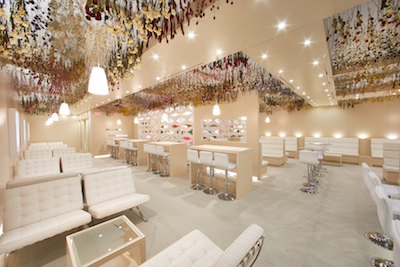
NetJets' Art Basel Miami lounge. Image credit: NetJets
Van Cleef & Arpels, Piaget and Audi have participated in shows such as Art Dubai and TEFAF as exhibitors or sponsors. For the London Design Festival, Perrier-Jouët staged a bio-responsive garden complete with a tasting cellar (see story).
Another venue for engagement is the trade show. From automotive shows to home design fairs, these events provide an opportunity for face time with press, buyers and distributors, consumers and industry insiders.
Switzerland’s Baselworld typically finds brands trying to upstage each other with elaborate displays. The Financial Times estimates that booth structures themselves cost about $11.4 million for exhibitors, and that is not counting the costs of renting the space from the show organizers.
Baselworld 2016 | Impressions
However, in the midst of a difficult watch market, this year’s event saw buyers in attendance drop 4 percent (see story).
Meanwhile, auto shows are proving to be a way to reach millennials, as the generation increases its participation in the events. Foresight Research found that this age group’s attendance at auto shows grew 57 percent over four years (see story).
As millennials increasingly age into luxury consumers, brands will need to take note of their differing interests from their older counterparts. A Shullman Research study found that while Gen-Xers favor traditional affluent activities such as fashion shows and sports such as golf and tennis, just a generation later, millennials are not as interested in these pastimes (see story).
Multi-sensory storytelling
Another way to reach the public in an immersive way is through exhibits. Whether held in a museum or a pop-up space, these allow for storytelling through multiple mediums.
For instance, Chanel staged a retrospective on its brand founder at London’s Saatchi Gallery in 2015, which included a companion mobile application to guide visitors through the exhibit. During its run, the free “Mademoiselle Privé” exhibit drew long lines (see story).
Similarly showing the strong interest in exhibits, “Alexander McQueen: Savage Beauty” broke previously held records for attendance when it was staged at the Metropolitan Museum of Art’s Costume Institute in 2011. When it traveled to the late designer’s home base of London at the Victoria & Albert Museum, it was the most-visited exhibit in the city that year (see story).
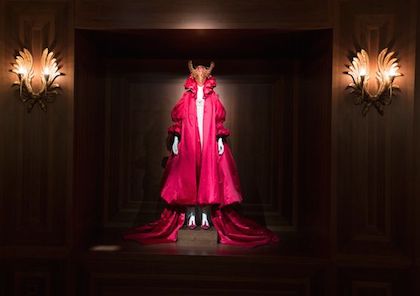
Alexander McQueen: Savage Beauty exhibition at the Victoria and Albert Museum, London. Image copyright V&A Museum
While exhibits have traditionally been limited to their physical location, digital media has allowed these efforts to reach a wider audience.
Extending its Paris exhibits in its townhouse beyond locals, Chaumet launched an interactive digital version of the brand display (see story).
Google has also digitized a number of fashion exhibits for its We Wear Culture initiative, allowing consumers to browse the displays from a device (see story).
Typically shorter than exhibits, pop-up experiences provide the opportunity to reach an interested audience without a long-term commitment.
Rémy Martin hosted a traveling experience that led groups of 30 through a multi-sensory exploration of its cognac, as they tasted, watched, listened and interacted with the spirit (see story).
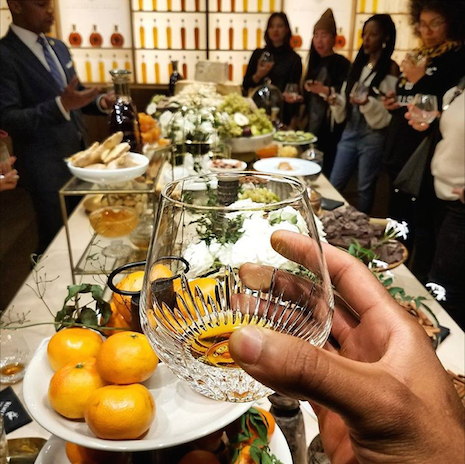
La Maison Rémy Martin. Image credit: Rémy Martin
Likewise, Cartier took over French-Vietnamese restaurant Indochine for a weekend-long pop-up for its Panthère timepiece. For the duration of the millennial-focused event, there were photo experiences, social media activations, DJ performances and an appearance by Olivia Culpo (see story).
Aside from driving purely awareness, some events link engagement with retail.
Hermès made an upscale version of a laundromat where consumers could go to have their worn scarves overhauled. In this touring pop-up, the brand also offered a chance to buy scarves on-site (see story).
In-store pop-ups can also combine the experiential with the commercial.
Breitling flew into Galeries Lafayette for a temporary shop featuring both an exclusive watch launch and a flight simulator (see story). In 2014, Kenzo turned a Parisian storefront into a digital aquarium, raising awareness for its ocean conservation cause while also driving ecommerce purchases in the process (see story).
Guest list
With an interested audience that extends beyond customers to avid aspirational fans, luxury brands attract both sides of this following to events. While visitors to an exhibit or a pop-up experience may not fit the target profile for luxury goods, the branding impact and word of mouth generated from these events is still valuable, even if it does not lead to sales.
Luxury is in a constant push and pull between exclusivity and inclusivity, and brands need to decide how intimate or broad they want their event to be.
For instance, an exhibit can be a one-night private affair, or it can run for months to reach a constant stream of locals and tourists.
"There is a lot of congestion in the luxury sector, so it's even more difficult to capture clients' share of mind," said Annastasia Seebohm, CEO of Quintessentially USA, New York. "Brands have to differentiate themselves from their competition, and strike the right balance when it comes to keeping an event exclusive, yet still drive acquisition."
One of the ways to balance this is through digital media.
Even though an event may be limited to a single venue and a set guest list, digital media has opened up the potential for the celebration to go global.
Live streaming capabilities through social networks such as Periscope and Facebook allow those who could not make the actual event feel a part of the celebration in real-time.
Applications such as Snapchat and Instagram have also been used to provide a firsthand, unfiltered documentation of a party or launch.
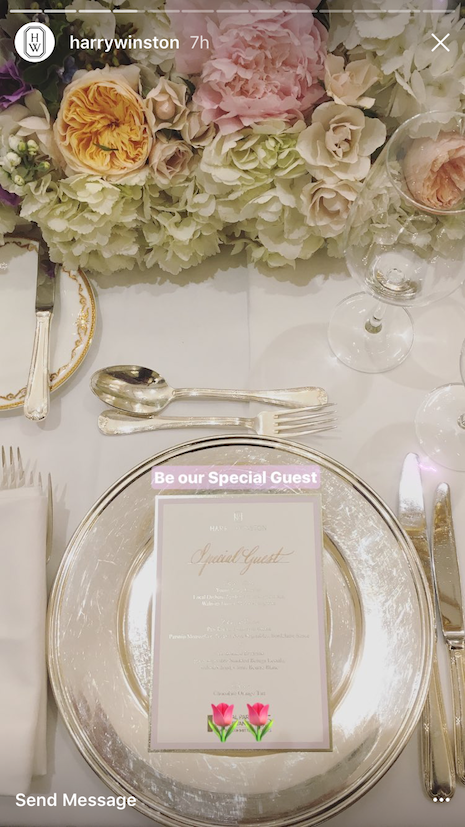
Harry Winston Instagram Story. Image credit: Harry Winston
For instance, these capabilities have become widely used by fashion labels looking to allow an unlimited number of viewers see their fashion shows. Snapchat was also tapped by Hublot to invite the public to a corporate event, sharing the official opening of its second manufacturing facility (see story).
MatchesFashion, which has a store presence that is limited to the United Kingdom, set up a townhouse in New York to engage with its American clientele. During a series of talks and events over three days, the retailer live-streamed the proceedings on Facebook Live, allowing even those who could not attend to share in the experience (see story).
Even if brands do not leverage live-streaming, party photos posted by marketers and attendees during and after the event provide a look into exclusive affairs.
While not a private event, LVMH’s Les Journées Particulières established its own Instagram handle in 2014, allowing consumers around the world to follow along with the company’s open house (see story).
Another way that digital has provided a platform for inclusivity is by encouraging consumers to celebrate wherever they are. Moët & Chandon used digital channels to connect consumers with existing events and encouraged fans to host their own soirees on a global #MoetPartyDay (see story).

Celebrate Moët Moments. Courtesy of Moët & Chandon. Photo by @dulceida1
Social media has also become a means for brands to build a guest list for an event, such as Domaine Chandon’s Instagram invite-only affair that asked its Instagram community to follow a link to get on the list (see story).
Aside from social media extending the impact of an event, sometimes marketers strategize their event around the content that can be generated.
For instance, Ritz-Carlton’s Room No.8 installation featured performance art, theater and audiovisual displays. Produced in partnership with British GQ and Vogue, the resulting footage turned into sponsored content on both of the titles (see story).
The Ritz-Carlton Room No.8
Lexus also hosted an interactive experience for 100 guests, allowing them to assume the role of a celebrity as they moved through the Mondrian Hotel in London. An extension of the brand’s advertising campaign featuring Jude Law, the event—which included a surprise appearance by the actor—was captured with 360-degree hidden cameras (see story).
While social media has many positives for event marketing’s reach, it also holds risks, as any failure can now be broadcast by all attendees.
Perhaps the best recent example of a luxury event fiasco is the Fyre Festival, which promised an upscale weekend in the Bahamas with music, yachts and high-end accommodations. What revelers were met with when they arrived was far from the promoted experience, with disaster relief tents and lackluster food that was in short supply.
Attendees, some of whom paid thousands of dollars for entry, took to social media to document their frustration, causing a PR crisis for the organizers (see story).
"Social has changed things for sure," said Guest's Mr. Pekelharing. "You used to organize an event, invite guests through a PR agency, have a professional photographer you instruct take amazing pics and you had relative control on outcome, so things were left mostly unrecorded.
"Nowadays, everything is out there, so each moment of each event has to be Instagrammable," he said. "This puts more pressure on event agencies, where the behind-the-scenes are also [key]."
Fyre Festival proves the importance of delivering on expectations. While important for all events, when working with super-discerning luxury clientele, this becomes even more imperative.
"As consumers evolve and become more sophisticated and demanding, brands are challenged to move beyond traditional marketing tactics towards high-touch, immersive and, above all, educational experiences," Quintessentially USA's Ms. Seebohm said. "Events are trending toward purpose, providing a platform for education and thought-leadership.
"Events are becoming more localized and intimate, with focus on building direct and more meaningful relationships with clients," she said.
"Partnership marketing is on the rise, as brands come together working towards the same objectives: retaining their best clients and acquiring new top clients they’re able partner in order to maximize budgets, while providing cohesive, dynamic and elevated experiences that touch a more rounded view of the consumer's lifestyle."
Best practices for luxury events marketing:
- Annastasia Seebohm, Quintessentially USA
- "Invest in real consumer insights. Too often brands become formulaic about their strategies and it's a missed opportunity to truly understand the drivers and passions of the consumer firsthand. It is important to have an open dialogue with your customers and listen to their needs. On the other hand, understanding the consumer through data, research and insights can help assess the consumer landscape as a whole and can be overlaid to more qualitative understanding.
- Shamin Abas, Shamin Abas Public Relations
- "Celebrities can certainly be helpful to have participating at such an event and engaging with clients and prospects, no matter how high the net worth of the target audience, but it’s critical to choose the right celebrity. It should most certainly appear that they are there because they are already engaged in that interest, whether it be fashion, jewelry, watches, automotive, aviation and not making a 'paid appearance.' More often than not, we would prefer to focus instead on the triggers that resonate with the true connoisseur and this centers around having someone from the brand who can truly speak to the detail behind the innovation, craftsmanship, technology and inspiration. This is ideally the visionary or designer."
- Tapio Pekelharing, Guest
- "Concepting is key. Have an idea, think of a new concept around an existing proposition. A lot of luxury brands stick to stay inside the lines, not trying to enhance the brand feeling or creating new experiences. You would be surprised on how many events and activations are boring repetitions of similar concept, all neatly within the brand guidelines and brand books, focusing on catering and decorating a venue and some random luxury elements as valet parking. Surprise people, engage them, let them actively participate, instead of only be the cocktail sipping guest."
{"ct":"j0EX\/\/OtF4Wob8nygXGa1hcyOr8taJudYk2i670KIiFLqvdc\/sBcdb81LxbR740g9mG8ih6XuuoUgsGsv0pvObUq9r3ehpPOqa3ZNHHp47aHDJoSu0E8gYXGuctP4YacAldh\/TYYuOvSQZMiwhMFCxOs8fgL8EUt1wZe9LRqrNTeVP191gQSHDLiX7MMcMgOoyvNJJj97Tf6iFqmF3pgvauuwS1m+1vMil2KjuDC4xyrSHUJKCRjwTRRzvXPwCJwXEIxZvtdgIlxaSm9FqnpPlQ2c2TFJK0gM7PfFI6yIsFDmBH0uhit5M48qyk\/aKH6xnfQHawV0\/CoYCpmZla61ywOyU7oSlwQZIYM1RDRZf3Q7tzQtJg8Jg5hIuCgDDko7AcXwEZmNGO4XTPnLnfp31hwpshpCMHMwa4bgHTFYF6h62X0L5qlMMwq6Y9KaCef1Q1wxFVF7toeMNvm9ysL5G97zk1+OabfupcHDktC0A4ZrmzLn88m\/uVPE06+z3jFyjrztsPGULY9kgT4S1Ej8eHyml\/MVlxadV9VKAeXQvzrwQ2y80eSV9My1LzVKH4fAXush75bzlKvtjJDiYhLs0F7O46lw\/z0ZT3lKUZCQ84nHtSKG80sCPnjUEthV6IG+W5cgrxCxb2L+\/IKnni9mOlkQiOuH9a9cdzxJizeeuOd1eKyY65n7HDrQqzUimjs1QQWyUCi4gVyMxS9raJzZS0hEGYintKtqbqUBPjOlEp+gPfvV2b9T6\/vF3nDWfnhsy5pt4DjL5vXSHmAtSTf9YklDjAF\/zrXNbttumPSBvjWM3JrmB3jpGmXS9akfOlQbIjCx76rZ69WenSXOMvqntL3VYAO5e+PXBt\/cDkYK0RABwnjDlLfBsGUkoaHJo+ua8ESFLvjhNwTarKSw9Y\/nKIE+uzFv89luCD+s9iNaQJoBwQTO2OfbiNpihX2QR9rAbX3fyC0C7Lc1HLVvl3HRzv9ssTdwlA3bFKfCAA3qrTiWUBSDPR9sG0HvGK\/BnzYBcc0hubWzT4LCSB21HspnCamjtB+rxDSJYc220zHWFa3giUgkxbgX4ZTUfpDhgJ+xkwrRMNwQ4aKKp\/9shzgQBF7OvTlgkTJBuR2wPuO6KxFcb4cpiQzrdB\/82g284UZdq9U4bxw7i9reLqaet5RgnikBLDjCOXH6jkYcykSa+kg0rFv1PHHOt3dEiFOlwztaF1Brh4mZxj0pSFV52V1vXeAdkFuwYZQHE3N0r8JJrsY5SE5gGgpXGXzT1vI2Ka1oaaRdb0ncA7D4rGSWM2uCPE35HgxmvxIM\/KTHGBPEEQv\/Ikc2+rIw7LN6nC46v9mKr3Tu57ZDvimLACjSdBHjfnFdeod3rjso9HhKtkJTZwPok5F+0IefAg2QO3VLIsNYCvr3vAHzedK59EQjaKaANKBx9XD58W+WFDfxJ7aUn4fPfWI1+s5s\/sNvsD1u9rXkmapxMCdgt6VpDrn+wz60pmJQfArhdWz3Z1LQhmGyE9aLheu+Bh9GgTt303rXYyVb5HQ5Vf+eA10pUNaoWWNYJLUNrEfge5nnvonalpsk+2dGltUFChNZz7K9lS8yBQ7RvbTMtzLRtJ1reFbfhE1+qqQ130JTaLds2y8NqW3+vdj1WbOAXZyEL+8cNhF+qQeUbv3qQBGvOi0YZlojAc+BldjtMSsFWZZD\/t8OwizZBHKxPzE8eASeBhX2nSw8yYb8gBRn+53g\/RZEXhikJcYl5W2p\/SNI85cRFy++B7erAnzZ9dmDP+LlGptofHU81QUeylQHX80l33HDkfowySpgQj04qF56heA0hxw\/MxP3dTE0UwVAXciA+D7\/PWoj8dJ1Waz0YpY7LOzuU7n3flMWrB82JhAbdNkMDwr9TFUj1BTulu3URP\/F7vYxSE9cB\/\/F6+LNFgGffvqKfbgL8NJmppui3iOKRe76vD3sMZ4m5GQfjeeGkHqSQTIWNwOIZu38gSOzmM5zmlVPYHiCViIDecBR4ssThnwzcxrvUn6T5cpxdDTnwiAWMCeZeCRwVj68s+Rx5vQIE98OjXoCCckoyOiVI0szls1u8sAXT+CMzmbT1P2D7pTYRHaTvEPFNRUOFuSwhh3rB2eShvw818MCuImtLCoYIFF+d7dPuimxOIm7AI4dRsvS3Lseu9NuezpGzL586dEsKrUUHWJ1l1lNssrcw3e5K06MVU\/HYJS28v2l6ceBnn1MdMAKbxDF1Pbp31eHjm6ffiw256NCaUi32h9JhJ1r8NgqO\/KSjqger3SiSZQHvEsLIUC01VpCme+uMeRgtIuzjLONc1IJkS371GyfnB773PgKk\/EtSzt8hOYQA8HESyn3ObeCCSV0PKZc0kiXAwpiMIk75xuSyFfCLHnfpcE34V3VwXyHYr9NUEs8pq+h04mEwGQ7W8zeyspkPD89xsPtZxpwuM8TmxC1EaFGhnmBp2xL0eI9gmGwJgHbvLV1VrabnRBEGBEUktgx6b65N1kXeyBW9l2LgjDY626UuXlI97NRWibOt2KoURzAPlC0Zxl8ICG3Jrz8AiBFL2GeoYk5bqd857lv5g8smk4DbIo152iYkQBynuncmgStMgu1HlOSi\/Kxfxj5a\/1Zi2LrRC8uIz8F6Ps6nrlPNd0IvTqgJ2w91f2Vz+1Yw7DUjZTEEFpb3DfY\/ggxNPidJ9pL5jA55ZZixHikFUkL9ludz2pQKFHWWR05F5HpkFqrScRYRz\/jSnADbbK8WwNbXSx5VYIl6B87jhzXkci4BtIRlVM2jclMy1U\/SIOUWydSBsM+O0zfyTxDfbsNde6gZPuPVf8Y3HeYGxQhaHUM8UqlLY4LPewc+gNQ3fKotaYGqk0g5kJBhzYHrELKUhrOfp5NRurKXoeKIhUpejCN42YR5USAlKHF4JgUDxKctmburXbpmPCSh17xE97pgxH0D\/CJBrxg927ZlX+kHnFulTdyL9OJou018F4Wkq8upxIsKY4Ue3MN7uKQDwr6byIKFcdpPcZmgXKQ5wlrVZr9yXyZAW0N8dxRw\/fWHMB15uCWDUWBqr2p2KmqdGJ9UR3YR7R9JkG2Zb+R\/2xrJYRCDpVxozUTR6lLWrFffxnhnwCiwwl8Bq\/ZGuXSrV2nRzMGHsv8cmjHD7RuP8h7WLTLorzqoflcyeCCQImAtHwO7jLQw9chq6NJb6CiPw4RrSFMDoLBZmqWFZ6zPUj8iJAO284FtzJ1DHcinfByNLYdR6bzYLRqGbXF7oivL0VuWm9XnJE\/7ML6Kulyz8bmU\/up8hQweOegWJRcRb0\/kjxczwm+lvhaDG9BDH0SF7YHviHmuEQ6JawNnKvltgSlj3WtPCOSmlTRh7iMYQgHrujc+2BGkNx82UAzp8\/WRFTIQPq+GwWy1ohh0hsJBTr7NaaN7cwJTV9m8ZxRB5pYe3z4NVdu1l3vsNXOWix4LffvdaMRwWh8UxSKnYiaRm7rvtuI\/SI\/Wye1Lgr6snW8Dbyz37\/gXnJENAOkJaFUYRZEOUEc4MySXshMG1ppu6iJpWCB9otAHw7jr2M6vqUFiJ3bXS257RQ7IXTFUETNrX4L6Ipeo31ZTN9\/otvatIaE7qaRWs9H720ZqAplkHponErstUD8zKuAxh\/34tGmI9IMhBABFD3K2b\/f7PRcImFgEMGOA\/VCU+urgkwpnxsM9H1ap7QK106yvSKux74boPDbE\/kwdBkyWbDa+1TEql5gYs2hE2WXbvjz\/waKv3ZvGPDgoh2kWmsJnNl+YSxFG64BPNoXDwR+69\/Ii+sJ6xu7q0URzm4PGJQ8os43frnxtFp7XF3nL+o2g94cAcNGC+tnzFiQ31iqZg0gtAD1kViLxQvRkt4Qv1XUjXNvN24qYYNx6uC1Bmbx1sHDcLTKkyYn0SGlYVF\/C1ABfD5eCV2WjfX\/4N23TD8AhqCyzeTJxqFZOBHEzt5nfeaTvxXEM1r5ovGYIRyB2G2b6XRHD2pAnY5M3S3wbSnb9diju+sPpg6as48rG\/PjNipa7OE8D9fj+Hej1vDpD\/w26Qy7+IfTlgu8zVsrYnzdaZQh3tFwBaQM7EtUtNGjcArHbRnSEw8KP7gyz46qa6IDmAZ6P\/IAVgiqkhIPJxAVcEE3gauXl0VeFZUOHF33FWVh8I4plANguKQNoLMoTh4T5t17v9luIgIN5WXhEfmAvKuMmiA6ddXec3IMYlfTIMOiTPwTC1SQh2TzYxvEAC2saTszOEq1laI4YZrWR2Wjxot+x2SByjpzaSjSJpvn56fMic19j1i31ZuNneGfD3Z91TBedELbzzvOPCDVSk5zszHaOelFXsjjyIXqfrgUTDMS7ijQSSVQk6mLbm0KK1yhPvG9FFUN5sVwMujupss707MEu53yNvN8k6HZwSoICAly4ckjRDEN6zUkFE6nnmCwgTtBeeZZ1JyGM+qLJlZU1JSYGb2a\/UwW8DsJk8ksGVZqwWWyEEmgZJdMqPIyH1qnWDC+QHr6HV1O9swWBCknIfDFWuRpKJ4oTLUQy3p42nC09SOSq5PBziyOyqjz3s2YF39lWQMSvQUfCEnmzKcMA13+hrypjrcr6STrydMUHPFw2DUv26P0746q3k69pK+Cq2j0wIQuYVcNiV5rKkwvT7uy0h0verIEbpDLjgvBhzAhuXOJS0aoiBEAD4+bzPpFz0DCsGPJZp6p6xHgoFk9D8hj5BLZ0F03byM3XAO75Prv11qVgyxGtvhOkKo7NPuumaxVjfuvQEIvHqyzjufG08sxH++Ipr3aWC1XHpwsDGFtNcrQtBgkaCzPsGeuNKwY6oUKMAlhNY9Q1agzgWTnLbS2IV5pIgeDqUb0gyBBiXh6JOO0mweLubHUbI3QbTgprNmbpcc1Horw33aWIW60e2hZ59IHn6+eFrHQ7rQ+fNjL3D2V58MisQLnFDZKHXiZQSq5Vb36Sj2GAbvMej9o3K0AYbYZsmGcR7ZIxFb6zqfD2iPJXiVVEuiEiHZhBpALOg2cdGjNDBDuF8U0Z58VS3lshDZYUXLfVrbwV\/DVOCaQV+a2D4FJBcjSxwxrowZbl\/AR7AI1BWoEMd4WT9cdep0IXZxb\/IQVpcu4nw0Q\/RNhkVjDPsA5gSAKIf3dqTHFfA6C3yKmT8jgH+xH50S674p\/WeqKoamOuH+2u0wh6KrbT4nKkXFkY0mvRbCn0trkURZsYXJV0aBrZLVW6c7s23BlNsiiu2pmBEQ10elVtRzW3+s1mFVI3RL2sdr7KSfEsw2VkmlmjQmjdbbGcOAj0XCnI\/q4cVMUUbShGHOidzYNX0Xg\/cZ5STMVnELEWv2SHfSK2SE9H2ZcK1sSwHZUR6HE2jYISNp9PTX9Wn+eD3jZ4KiKi7MSlUpej\/tZbLqU+GHpCIGUl2o4gAmbZ5d69O6cSgqAImpg4WShpsdaoqky1665FhLyH5rNOhv6hknKm5CFD164kBf3eRGTwRbi870Kjg8z8LPAvenbDxykZSj0ukYsKjnPtjVVQNsARLpX621QfCtGWzDzSqJxU9QOW69qfXs2q7ddsYt7QK3qu310\/O43D4wBHVrIYRBhzWSC6r1McMe3v8BhrPFZKoVdCCT1ZLS8\/PCLLwUFLqWZ+QqEY\/bxSZ9\/rxLqo8MwR1n7uaieHORwPHjzKEwv8uQMeGscpU9efvKWINxK49q\/y6D\/\/8i2rCEOJCzcE\/EBcnBn0vKVphx3+g2CVaOfzAy5XIkFJlXuI7OPh8fgGAj7vay3i5GJByiE1JlZ7xX\/5wsta7fE17KrlqwDTbfXsHQh\/DxghYgmKtLXp5vJ9zr65IRPO1AwVgwUe4NRET1ewxMlK+Wnc28ZcCSPXB3c\/Ol30S8972o8VZ4liHSySkzS5PlJicswpgVEkE6gCrPhG8Lh\/udOrcKabBA7smvRZIQmHxrPbW1WRlAcnjBu9qzGIRt7sTgi5ZzNsxOpv6rt39wugZNDnWlD7ZBr7FB+h7OsUow\/taitcvSIjo6APEupkdnAGu82Z+snnkfxeROF\/18sPMA1zJ5sSSYnDg9vrkOTkOjVPART1OdMnfbrEOUwKfiQ0yxpzu+AMRjWVIhmcIAeFRQZumf1D1PXORfnDdCeHKbD50qloG7AbPPG46cIgAxbdyTutO8BJXTFOgfSUc0atsM3OA2Yjp43Xiv+gT2f3DjQBjGbHbFpcp+05PsviF64e0KaIPb7bJ94X+lDk6sJ7\/ZqJQKPTsMtwiWEvK3B4lART6aZ10ToVx55EvBDiaaIvp4TGoOjD9Fvt5zPJtH1xYoD1R7f\/1z0Ya8LpY2KQ2T9YZkid3T7OKgJS3elMruTdthAT1a4ANl4JsXMH8oEv5v0T5+E\/BMRVlo5Wr27+cbV9Bbcr+W\/RxhyGastRBN\/Uaeupmda0a+24hJCS8m+2uCcKIC9IWMALPuvDcrd25m9r5ZdkZS4qoujKnl5QmjrZlJpVuysSULusUWs9rVky+yWqpgbEol54mi7qnP4Guj+OfHHvX8pwtT0Ln4q7JMRXf93wkz922nSIM6RN1FpI0D0GFdOFwyxGnjouv7XoKw\/wGZiNJj3QUkS9N2VcmnQ4rCJn9MCAiExQ54Cs\/ZjImD+a0SRNNKkIaBFlE+jbqDo+HV1GYmPf0q49R5V6Fitc9HXehVQWxuzGn64cJTaN7+24ZV9Q7jbjcM8X9GB8+hK\/y0gZmQzfm7seKYhiL7atxMph4MPylfESY8X2+qumNyP1ZwzI0nUiIpRf\/\/6sHQq8K4hQzdT986vff\/tqy7okOwVJ\/kxt\/mTLH2BkMmHKP8hoIACNy\/KdjnufYnWSaG8wGWD+CFxj2Pw4bBavDWgLkvS1YEZvOyePm2DPOWGQTEiAhOB6t29pQqPeArN3wWY1+2eOV\/\/JZ3xnCbFn\/Fbb7EvoP9Kedqhtd41D8p0PF6Ngw9mbkBz4FNSZx3HNvNcE3beUp\/GK0vOIUu39zBYq4kz5UBjva66UX7og48Cs\/Pe6WOIt78LvUlP48vfmTqPfC1wmSzaRpyla7t\/Vffwz9dewypMk19GLQ1XDC3jAriiJm20Ah96pXPnzZL682iBYdcCZwMTRS5pNk71hPZSWwmPYw+bYG\/HfCgWgOIzUkthz+UqpP2ghyiMM3GJ5gQ\/Yub+wXA\/21k\/CZZQk1GVxvckoYiUcETkY2y5HDEA+jOLnbfIVf7lfa45LXX3MZ+BgLdBuBYd4G2AhXhfUwT2VjEFGib\/cYXAu8HroX9jSYWEMQoXhnDoa9liSxOoEmgrF8rCPOZLcic4YPoQEoKOScA0J13aL+jURgl4ZfWzbTDmfFVy1jzvQvJKzyT3aRPiWLZCyTNUO3nDXaIm4y9lTaFavg5lyUJBOB+imqY4HnAB6KNVLResgU\/v08EoZRce0pXkcrfHBbdU02+Vf4\/Jb0NZ43CygBbY55iUuvi5EDafz\/4VKHDVpdDhFg6y77RBECJ\/9s1xGGhk\/iQuITCboao\/POQ8sPoAfnaJxxFYF9SIfqGgAnYBJZ68oE3fV70OrMfd8UzJ+rUkPNY\/faMH+hGzRv0c0Fm42a51QpCYfx3eYZH4BJSNUNqRePFNRsgRC9YuWQxkhBOjpzVeeME1amTs7KV\/epvmaGSYihLsyeE6a4m42UjiuyZRW+DAAfJEjgDK1a4KtniEIlOf95I9ICjtkj7T7Hzu8gkYVSZwWk25869lgzjlTbAaHdmFXMC9jTHOMYrvtBFhtv7EnJBI2+Q879KbVzIgNqAjQ\/VxStPMBKVO7fN+qQi1SJfJnkjBoJLei\/W9cRzuj9AJcZopDgfTXYgSdaBps1PbsWxDy87DyNobjH+Eixijkhx4PoHloEteEAjOshrsT7R5E7uSH+rqADu5nx0lyc\/hYsQkIvc1cScpREdBhA4uZ8s79dYXUp2EOsVRgFAMwZPpSUHev+UFQFTa6nz+ZXQTKDZegJwnCbXgKz0IW5+go+cMutDqpBtsrTvyV3Nc\/jfJN0sth1LLRydzfZQBnUXIoEHzHY3YVWEjxsaVFl1OewGmiM6oYekuQytyK8wWhTm\/2xMPGdH7jb4WvAORML96UjJ53yJGbO\/4H15QKhI1NdrC3CFQIx9QV52exP0oSgzG0\/TG9P7i+OiEcucd2dBEIqh6iyHbiho0DN0lREaLKiD3bSBmLE2TTcUpq2+RtbSFp7wWL\/TI2HxMaH5K8BmsovyuCRNdwpKywYugYYZ1k6gPEUE842gcxHMhP\/vbsFjvW1XLnFJVFeky0bVjp9aGCODJ5u51\/8Ct83v4Pirlzsv9ywF+QX6wtlanEE6LF+NoG8mk1Lw1X4LrR++s2jiqUFwMZUtytKRQ1pGApvPGnbys8SICYhKJxjX\/ivuWjYn2cmvPM1FkwMv\/5KRzB4hQ8YxoMnXIX9yz03TOgVtGz17+nwEfN\/\/b6s9pgqwis76vTeNtYHY3SHIIY6EZho\/lgCcbEudl7Pr6\/Bsdg21t8UlrJYSJvFaRQe8QCMMiheFRRTTvT7xDlzeQ5rEfegPv5+io2kQYIiF+8DKF4DwZBrkJ8Sjf347aBLK8EYdvfaOQ8y4VPcEQH3gUQ1dDXqY\/m0AU6Pn6H6Ytb5VJ88W3DTJAqYiZeWvYJGgCzxiAmM43YevdODJ9PDkmH0SKyrT+bqBh2N26h\/LOhWy0vIAzQkYO7OvlNvecdtvge6L98UHHMG5qH7lI2FfUGaILrDDbIsGfFinK1waIBvE6Az3MeNlKl+igYpc15Nf3YO2v1zXRU\/8KIuYT\/XHMXyxW3411z2BFa9eDMW381CHUaPz5rB43wOjLMp5pvN3ZCnYUzYJWf+6zYRhkAAiGCN90jFHmA\/2SabscDj1c0R+v6qiN5FfVPYIlMnWPSHLKYsXS1o7GNjiDM6KCSXmiiv8BMVyf9l2dcDYe6+rqycODA55HpgzNGa4ZmCfp5Uz3x77YV12Ps\/n8QjggrLB1PXgQ1PFjzWuX+8zVMoWB1NqU2okmGCn1LJF6Xqh0\/b0xe8YdaSlKlXoDIoh0bzp+l0gkdjWBHvIGCoKsTxCDiCLQZGWSaLGKjfnA\/v4GCANFIHg5stjcRZWjIjs8NYVjq9zdv+oPURV6ehggLrVGF\/OjbVlzHTWHGtk4pdtBgOO+YFC462ANSSuE9+LmsJ1ZpPnx6+A44rysqlnaMvmNFbktxO9+N1BXDHL7Dt0DOVe9IFspTazeI3RxjWbB+AsXBuYokJjU21KNNkyg3zqDPJVXcEH+acnFZ7+dRzgW32od1DHcqyaHovAA6M9cu77bSSR9BI5WoGxTt4Op6kisoWPFd5do0KSO\/FTUATZorfQxwKCO0Ekn\/9eQVM7FR9mjWpC81VMGaf1PcZuwycHsz5xEQzkS6TS\/9MuUd6Y8aeXH6TJYp+PENi18SdrLAi4EBkpx60wdhb+kNMje0xkQk12oWgigDIZ7HYdeT\/ftYINCl7Vj6Gp9SuXHSNbu3GiJJu6JtJyXpO0KdB1deDPMlwQ1ggE5yK5qPwHIf+OeY3cP9tFK53ohPnP2cu7RDjJscyR2AUj6uMlx7IoEtWhipXU1pWN5axcgDtok24pOe9BmXM2WtGPeKmW1xmFrGrbXciiKHL+mbn5jZ6SEuGQ1IQ3XmjUPNd4PJFb78YM4cbzSG9PlydmHOY7IIi7d7QNtcJ3rVnv4Fua7mqf7J6\/r0uveHBr8HPC+XijYwvZxW\/c89kBxmpVJRtxrOjMHDnlOg2G3rtiIQICzRQXBmg1riBj0aewjekzsFF\/DO81wFfz88gLX4gvd7iNlyCFVxEU\/noBy1S5jAhWAf5MpOCz7Tc51KU0HkrlsBMn0hOnySHzMicLgpJQ6bxc0aBzXsh\/xJTyxUpkwOxdy4s4WxaoNA5JNqRji2ZVNp44EESbpPgONTuuH7IpfvKrrWUL82K1JAzDdWSUX3+llk\/kXH1UIU39+P1+ofyI6b1Y16fHiK4P9vpuN20r\/lNckEL78u758wFp5U82ggLZMdK7OiFR7U7MLWWyEchRoDWO9yZKkU9Dn+PAMcY2oYTqLwNkGpJ0gv5lUecekvAa3vGEJ81VIFcaQ5dTzuuHkWmqldVMI6tHxkwvQs7RG1LLgfqSUKPmFz7SaaNB3Ew7bClUPLgmklbn1Phnc35XREu7kOMotnXsNpX+2ydRPF58aeBZJv4qKmpQJsuh+FWa4zVJ1BSv+CXTK4J8NXPfz9CXRoKkhsXaIO7d5DTURtAq5x11k42C6lRDRzkAAOYtYFfQJp4QpjtIlQnY5yV8DoOGHdribyLqIL+zlWfKUdfuIbegCSxBg4+TRQGVoJbLPJiROJqNEd+wVOW2bjKUJ\/afuwRR1D3EY00FE9Zn6\/vniTInUQ4rY55TgyO\/WA2GuAAbpnxhJVA8tInSwuY64kK2ABmoata1xmkyKyg94XWM+BZQP84iGzUAOtK87AsxfRwxf7ckppX63TuDryPn2olDmOKRaY6J0o7lgV5QdiBBPWQsG9MDyPzZxFLkWmV1i4LmD2z\/phc9JA2sm\/RstZFL51jvG0RSkXbqQQU70yugEk5HXrrupxjUv3Gwp1TD7UpTT98dYB8XtKhporWFvjPyx2ukG4J50IXe\/V+qk1FW329q8FlX5\/TelEAyKCN03a6dxnVIrwf9fCvPI8qSs69JlDxdXye6QPoPVfw1HqyQFzqIFMSq96400JGaz2Qdi+Tc3u4C4gEfUVZAeMAnvB6zSdblRhlA3JsCd6lVYXZkURZI9ASsaxo6IdXgJmJN9aTuexntAZC1ahEA\/I0XX3x8cRwSnoRbCyRDeDjMQ3zq4MEET3HyctgYHBXr8GozKzovaUcfNqfMdk1XrrxPL0JALJ4J+UliCrx+30u1RXEY1\/9rtQ9tXZxaYMGdgSspXRevM4R3bf4AZ285uYYuR8GMTlCmP11aOTJooiNIlhL3++J6M963O60kgc5O7U3NDoIFBzkGg73+6To+Bdecl+hDTOKl9l42XwZ2FR6JySu6mcxKnAD2RH9qyJnTyi0iJ7YJZ8BUz7BDn51n\/Onlu8BPJaNpM7ew68bRqCAy1OZmKMes+o\/G25E3DGswIUI\/hC3eVcGE8dtKPDLov5Qrz0Nl8C0vA3zoiboMgH7S9dJqVcOHWDfxpdR2WNN2AWU18JnEOL4MS9xicflkK7pycPWKGOEIzx\/W2OrFh2EpySN9NP7AhZ6g\/gHYkvCuRFjw3A4N1fcQl8hOIblQVmtq\/qgGlTFsnrrsV1\/OwMcM5rRhYmlcNp2KtG9t1vFpY9DfpAr+xJwuWKchDzXIATQfEO\/+x4kjaXBbcH3whtnCO4vhXP\/ZNmKJ9FQghRP799HiiVx2gOG3ijw\/GgmN6dhjxQ\/OPc9+ISm9zui9Uelq\/Jo3U114IEOKWFSnoVpRO9rq5YXcYKjYbqNf0fA1iTpmxgsFU1rN\/kfbkFArf5dznTyaR747WO7a9uQuACjK+k8XB3OGtBNbug0zPEeF5T07nxiVwQYE2NnGP1nZ5EP\/ciNZUb3u6aoWt1p4XI4hBT8\/qrW7nW+50pdeGKRFE0mMNozNLJh42Wg3TwK6i2qlMVlD7C6QyOntNwZ+aSDVzV457RX\/HpClPM0EOhtpU+Ny49LHbwnl3Iwun5Ya+1FN7coO26CYlHFtTOQmcal6S5ynWuAQpR5pJHUZYtH44E976U10+7bX62Ga+yClvHmOOfsbTHPIxcWjnWrC+ZDeip4tNYJmQ6e+dR4k8c7f\/aMoThTSzbvRzOuvs4bQA9Kwsu3JsckULmHAGag0mt0zMDmIEUxFHrKa2XRMxmXpn49CtgneeIEtWWJ2LrBGQixIzQLLeoH36KCeYpFxoWxolwYMo3kc8zKvgnUZu\/Mp9zRzpK35aQ2eknS6fbq1yVTROCNNtIihBj5f\/GzF31razXZCL5sQwH4CMdJKfy+UM4ac2pKLXHHI6Yt3RHWhhvwNN2sv1Hhdxm+QLR5SNVr4q9Taua7ScvE\/i6NCtulaYmJ7JgS9Pq\/HgDchkBtu5EcQNyWxrsgAcRVqKLzwj5VjkSE2UIlkSotA1CLKP0aYzM52WkFz1fwmFLBS\/5orx6f0C9IDXfO6ZZMLIhmbvy\/+nI7pdpNCLL9CEXTlglc\/RAqZSvtOoETjV80PmkqxLVJUHjfbMgIDsdRXAWoXRCrna6NofPHM6LTDogysHLvw9J3KdRsdOX62CIVKI\/05t0ZU72V+4jkbNv3fdrlq9mTNFnlQHNLuszdpiqDLLtzrQL5p+YIfeG0OwlRLtBhDLYtUbqRZRXCuyD7Y3SJ2o720H8eXEDXrrjfT08rxIyMc78eaFaHEgTxuPkIul6z\/IsMnXOGZibe0Y56+ErhIUh8gdtjWmmckuDOEhQHoZPs9c5OnYuvk7U7PsG5VcPYqS+oHnDGBYQpIL37cKYt3wwJmpbSk73UEG55BeDWqz03lC9vN2TJEB59F5I2GiwqHhHO\/ZmDC9LzcyYOeHCvzciA0gBZ\/v5OLhmDtCK+urtCJUURhBth4\/PtO5\/QOnDcRDOBbGdICNv3Q4YtkjqRUBgklimMFFU9nivPoPHcH8EBpceBSrVmWnsxy\/xvj6sbCpyRWsn+T2DyDiZV7O+v5\/6fl+6uuYLYfCpN2\/uzjU1KoOeS0eiOE2yR0JaEfdirueRxsztkJBbImre0vPjiR2WIcX2v4HX0w\/nu+QbkoK2lUWcBuf1GZnhC0JIwvJulG1AfJ\/WeQZuM74LOFAE\/w1wcP0CA+gpFx+kzUWF\/GtCZCpT+pzM3TOI1ua69Jmc2uVy50XWMleSOP\/4ZNab1GLMkwl+zu1rdRVRuMpDYxb\/jvN640wJSkDMqYjsy\/Z\/Mm0Fkro3ZEdfSOCAAsrcXqcB3dy47aectMnVF\/D63hWe0yvWBgE7Z3pIX+hNp+AY5DP4rtGTdjVsy8Z7HpzydA4KQHXCvwjq5deonfCrKxtq52GAvx6Fps74Y6agAP1sdK2osffNIuvxEJlYVycerk2rILk78EomxxFrwkurW0PotpkUYOXlAtrk7OX6hOPUloTSX8MTaPHCYJziCDN7oyQCwUCam4C2+1LSMZIRK0tlgTronh5E0Cem+TcMQduLksiDQuQohmY3lJ3dq23EKIClDWo4KXsefsVUWdzzsuGOF+4e1n7CxIAY17w5dn9tC4BozdarZU+\/xSobNfdOlIw5wvh+sa5NMdVfoOmdlWEDvyr3l3WJ1AsUDeJVe4zCC0QAyxzn7ixArFesWOIs2zBwkTffnuqTO7s2qT4SqgwCmy5gysMp9lEUmiUrqMeUSa9QPWOvAbAYXuwmNDvabA93N0XjUC\/eBUV9F0WVv1sK04wZV4yHf7+g\/5QgBgYlcfcGg4kycbyF+nCQro9jki\/wsGG3\/BGCPBbofw5BcWf9s85hvdWd5hKChBFUle09mNz5YkN9jpJB\/N1QmyoEgLY6QlwnVk4sM3JQobtFV2CIGD3Ci3QBw7zFmOuarr+TLI+NABSpAEwPUvrFe4PLAPNr3OmtvfovO2eq4BL5u6nmUUAqAQq6RIVSWkw+HfyJoWRDcWy\/w2Z8gdT3\/utDoPEAqggNby9CiJtpw4XgC\/He7hBjdv6yBb589xhIxfeiclXv9A2T+8C4Nf56Fyl7sCEXEQ+E9cnLLEk8sUG6+z8lXovaVy1xu6pOUkSw9TYQV\/XG9g4TT2jBaTn\/b+QmInE+p6etbFiV4PJiJHIzSLNFZhu9MVfpf8bTpaiopqfRrLmIwj1kzY4pC4OFBRcf7NLJv3IwLfj0HzfVmKtHYwWpU57QAo+rcvdjHsz0zN6aR8seDbezhEUcnZvAjt6d\/iRbzSPlyuNrzey1YEzHdr37yF78weeImgl9EuwSXFDWXqD7YSWbNKhWPlgprOPSibLjXdzN0EkA\/EZn+07\/B4fRaULQVqmP0ON4O4w9zoGHidsaB+ViTM2L0kpaM4b6v5fIffcrST900QMx\/eRekMF+l21RzMJ8U8T3jBMiuUPwxhCyGzZFbD\/6bhrzN6O2fJxCPlMfCFL9BEYABDIjG+5EFKJHnZaNVuC6qSssFNlgcps8A5TkzdOCAqCQMzhrQG0FW9dpaqhztkHdki8eJkblhhRblpE0rw3LtEgO8cfKiYoBt0zK550BInfhpJiYvZ88MzyUbIrcsQrkYom3eITN2deNGVGYSSRTd8EinXF\/HiQnlOXODP3IXiAw6anvBF9ezsevV\/cpUICSr+T\/q20LyPSdAWnXp1hayYyXx1SgNYw4AEcJkGR5qRJpPVKgm8Nf9abIcccegkZXZvH8bOllWxO7o8eO\/bp1LJIWJPYvMfqEoNfojZQICj+OWRgMgNFyrdnENXr03SI9DlQAUjKJa1DqOusOxgTQCHXhfifA0ljb0mdpVxbKkPxSfqFJDVGLZqnSITRADs2m3JJZcik\/ITLzFvqy4lDe6sUOgW9z7ZTkzp1bXgo8x9lbsirpEn+e0cAvgSJYFULEFnMYGAscGLJMACTILBtNe9neVBekjApVOMeSCRT8rpxI2Y5xFZyOB0tR4bphWqxUlLXCdyM4M1Gd3Z+rP+bJ4ldDvnAnnLADXLlTBowBswHOUopCRn\/Ukk6mMdBkX5lXJix90f6FU1GWjlomgQYs72ilS\/q+7mUqPT4OFh7rnSwwSKCnRmyLQdDGUw2R4TQU1N0ZqDFJdH\/w2fpaIA\/DVY\/Gxu1jL4IZTRoRV0Dpy1nS4h0BG6WVgUtZ0dJukkKZw+kOLNYSjp4PXcM\/CFQO5z8Rr2h6iGgva377jxJC9Xy0D4k5xG\/Ha4LUR\/gsuYKnwiPHI5iwZEZxhureGZVOXhk9eLakhhxQkt0ysR9Y6HC4u66RyT0s9Y9Y9rNrCbhUQE8Yh0KHU5UAowB0+iZdtYZZVeFcU3R+IyWc3PsqXvEaL3+TogOnlA3C4gRe58ZJUPdzDkTOWJzmtJkDHQbG+TnIThp0WEuDxxuz+GbnOj+Z9VbI4SmS\/Uzw9pqWiVkrakXMUrEzRAnaae1cB\/iet+fNw+c3TCS87xWkPEKMtxBxOvFkAQALN\/EFkqT8EcPp+g+3Iadge9fFLIYJ2\/F6gg5MbzmblmBsXmBymLKUOaCq1yUcOnRulXGiL3DxvgWrKr5ec2YdHHU1UOQ2MZz4DXVN\/QyRbwqepyxVYIx6IKTuIyQwZH5P3Cp1KXehciLYtjEWJexrBqiPE0uzJiSOYxozYy17R460TriGpe\/avo7ICec53a0ess2Ow1wdN2Yy5GcAv0RX+cCLAYvcp18Ew2y9s2D+dn3eVH0CXkTrDcOvi3qekvzD3moMsrFvUJbHBC9c+bgFPUpfom1YJiS40Pb2sMR1RUbhRlrnpPnn\/xfQuTgL3sN6uz1aSEb+5cQfVNF60lEXXZTVjyUa8ftmQwjtSAcUraRIdQL\/rzEFcqof5CAgwXOlz9diiR4HrrgwtbxflLHqd5mnoG+Y+H2YERFnTn6E3EFQlG7duGPkRg+MF7+BOpnCwfMBlGJf541VO4UpK6NMcsXE2AHdr43N3HZD8LZQuvNr6ERaWyyvt1uwYTr2z3b5j4lnOWIBJAqHRqtDhaoGhWmP6WAgCrxdAxbrN0z6iVoFp4eMk6koOCp7a\/JFVY8bbCtfhSfDjMMhzBlvnqQYPjxDI3kFDw2\/EltzUGRKHAd5svWnyiGtkERGYnxf\/RRSlmdrYdNVeOSQtsWxknEmQqWRXMTyWfC+YKUPejPH1VdT50N0jyfNU4moA\/fCOb03ogBL1R2Fpc1f\/iyZVHJTDaaVlWAyE0QAlg\/ef6lVGbgPjx2FkUbxee2Dl2haPrszKJ+jZRNkDhKFIe1sMI5x4i41FlKuckAkR1AiIgDQMowKATY0NJftuPe\/vtT1q\/N7hzdkpvjD7WmPzrIr19CgSouPO5jLdxb7nGBlD4RuzW1TdgpCGXOtQg3E2cZSwYtdIQgmpUbpIU6tJOnHo1flPiVCGX8p7kMUDTyffkaWN8FzlJeHBGjq8vD5oQubiWkmeUTa2JQvZhOzMt5L40sXxf2BKMb4CJGdSDfQpHJB+iMRUIBUU6JpbmSJsTnUJinMJc4HrF9mbLzLLEZzCnynrgn1uz+b\/2\/svKsm2FSK0uCfTvd2hWrCRO61k1U8NmdNu1IULfEDh1wLoZ63jPu53on1GDKRdOmBv7Azno0g9uy4kE3i+WNvwzOh1JmmN2d4ncj7PrGWQF5LF1soGtqr1CoYM749Fyc+stfnkV6PVAVZtsgosLEPx+fiLn\/pYfkz\/uIWYRSmGjzUo8JuGuCLtin+N\/4X25KuXpls0Bukl3pTeqv9p\/iAMLGhrOrSE\/6kyQZaWWRAqrEXjSnB0nKYH+pVCGLFdM6XRcKwKrQESbUOmr\/9nLLbnRj3+CHECjR0muNwigvs6z4ulmSvB3LhJDgjvGt\/qImwKTLi68yTmZau7jEBNNWUYuNB0nQJz5oaPw6\/T4SCiCwARO1ZlbbSddjuL6ijBzFtx4eFJPmGNczSdKcGH9g1JflYmDAzhU9+aIo4Lwnb9HnjBxxPQX4CdHdXN+b4yhV2YK0Xt+rx77Sw7iTyFoNZiaZOUXOGKm5y0ohlnN4GuCjtKWeAX1pZSV8fLqzkQZs9keTgpPHhxZh61fhulZJsrlCWrnLQDFMfALmfmiWZT1k1pC+3k697gvbJRFFFOuVez79G2sFkJPaAD3V2Wh6sVeNcTfTuuZ6dlmsQFoRal4IN\/14IXbL0z1n2pNo\/5uxZgePj4W6fuGjovug+ujH3whpwqlhVZHPNQQtAcjM+N\/o18JGPfKbsRc8aQ7yGrdbZeLuvnQ9k4vn1WTaLSP1x9DBbSpW5UR2Fhgk1xhqL\/AX6Tb5oDYFtVzkLRhEYija+tjA9dCxMdJ6qma+bw86ji31Ylmbddqm9bQszAxd7lT66rxedv2sa9o5+0KVOwxlaoLZJm7WzLI9sbjrCZfU2EfTJv0IMBbsyPeFVBk83QrFcQG5+oPG0s35\/lIccMbeFcfgTfoxcQzBJo6KR55vXqg3T\/VrHcmK\/RblPNoidffQYAAEzTa5HN3Xse66g4m3jMD9CrjITXvlu7XloIxX8VsC\/8LpMZB2r53NB\/wztVz6vI9I8EF1GATZTPg2Nj+g6w6BUW1pcsH\/zbw9pAGa+hEH6co9avvA2f+758BTWVq7VJm2qGw9pnkq\/W25FvKGvGlLjwP1kG675+Jw37V7Nvx8KR9Vuh488ZikoWcdRwlq4F2SyhSGtMT\/PuOeDI\/m8JPEGMGONzCFi\/y\/yRajsIyJSeT\/oWwQ0iYWVHc\/MsqqQTAX5z0br5dFagEwHThsVzGsYq9qvim156pEQp\/WgyEMLeThn1Gj9gnOwBQxK9Etd4Fy0OtgIcSlW3dPOvc\/KH9l7lZ1zN4hTveGNTA27hEXR6WRRE9T28pQ0iDCTdayZqBs3r\/nsVK56vzrkMbRvpTEkHJj00M5uTmb1bSLq511H4vguOpjTi0gFana73rS1OAiTVFtPTevkTghmfoyWlShCCU\/KGN6p6NjMit2awHajZuunBiO0C9+yCG4A+BooaUuHYnw7AZ68+YYsL2C8CDbaP3dcGyepKVZcw9XkPO2ybJfjXe1YWoIuwbRA74gOtfwhQIPSv75LHKLG+OkeBM3fqTno4tEsfcjpAE+WUbnW6Y7OJ5nRQup0i4MQTQoqugEtEBSnNKp35Frm1NXLIrVQkaRDM4joTYXoY3FuO3WAb0DBs\/BWxf5d+37mQ6ZlM\/b2IRaZTOONT2NRSrmbZUNFrOfyztr6HF0hCjRAOszXiZh3cDn9pCD4VM\/\/7WSJQzbh7WX4DYbINFfQZMP9h8eJxa7ayANC7rvmFfswdacCMDljFrtnUUfFsjuKiyUx3Rc78b81RSI0LZQfcuXU3B1pCD\/YGofp3M\/oVbe88BtrG+LSgWLYFdfW40skpNWt6KfD4GYywXa7zcUK7ytyuNAKXwnuFHv1D1P9PCbx4WxauLn9cuCBP3dUG3YjroTRvRztA7wHQ9bMBl0waGTtXusVceLO8QFkXZccVOI70qXcFFfwg7NxAiQvdVbMF3x75S35HqNFBUgstBHYAaij2mmHRJwwScPD+3pcN\/hZpxRnMEnTsGBLMx9RSkzv4S02o49y4YWs3krKztEjrpxUK4bIY2rDM50olZLiwGsTnuB97aV0jDzZgmGOOkBVF\/WVE0GmuNDZZKN5b1Loox7QBNA1O3D8wqRh0L9tDwPnVKZz\/BX3AN76jnukdTcnvnCaN0fjzGj2HZxl0egbcKRAuYgkxiUYeHbYZznEObyEm+VfVfLU1MfAq4BZgTqo2fLMHgLl\/yE8b+J9lhKA8vsA6Oh82\/uwx4fC1SmSSOy8jumtelehR4uW2bAFLRGAMvBPY12oGLg71RXUTxCrWBKJtjZpwPulUmurbnezjlkrupf9m79Zh7D3VpENeegkb8nqkEwblnWGt2I8Cu1ix6UtkeW6di3wlPg3gebna8Ylg7TK0f5iaFacy30GWlZTTx4t+J9tUI5DWVG1+2vN9tr6szqDrb27Bt5CxPPux2k1Jrhn+3fhQxIXTPFzssnXGwj4\/MKUMg3WL6Zg82wlincRyyF8zSpJ64fmNG3aA7HtbblQJMTuGqLuTFJjSkTHZ+UiRw02TWnSumSmIlI\/vbG62PkVtWhtIvhNb7vI+iyU9ukBZE10QWsed6JeQffb1QrbPeYP338O6sGqzVJ99gKcAugQ22sogOmoNH4+eypRpQfL9EZH\/13K6R10ykkawsNXyhK3koTFN8NAs9zVNmZG+2gxZEzTBkqGFx+04NDHd6FAzUr113hLOjBkJaoTmbSbUCsTVi5xkzDTU+sDyg+QeZcJoZ7tQSersa2mOg2NG40axgv56uGs320B1ZTVoy\/wP18sAKZakO24nx2tX4NiORhPE2QBzg9VbWtSAur2Cw4sxjitNpjVlkefnn2T9lCCdmyHzjiHG+n5aZd20IZ05p+53bFuikhb1Ga630IHJwl3lYNDTtwuMjJVmdW8zSoYU7HEsZuTG+Q6+Q24oBUENhO\/AZHLlAqCB4StGbxNLgAliosjCABjOuyRJUIeqc83+j01tPdHUylmBd3b1hCL2UqhPSRAYr2TYtVEnBtwDnNftY4c93Ba8txK43htWY0wMUFyOcU2zMa3JYQfsTd3dDdFDsMfMZ+eZPLidE2\/v2o8I0FtGtkVZMAfL3Tt8+SFpq9l+oO2rw5AUbaoYl2RPerYiQHjFm3GbeT1Yq1ISY9zFmwd19qYd37vzqyovwGbWWHkrlJ4mZKOau1FtS0y7dLt9rV7f6hbkAIPYhFjw\/KSBly5L01Ei1hC9cAPkeS1c9E7INX13+YXZa6SIwQT2+m0sqVg7FJZ5vF\/QOoKldAuArW\/B3G283Qrdo78fXKUp98AdbvYlgyHnrFh+uvbD96BmeR0k75ztCniGOBUH\/opkAY7y2gnhGKOQ56d7lMGy59Z4ErRXGintWBj+3fSdsIJk4\/uLJ9r2Cq6hcu3y9FIsXGR54jgsxUlgVYeDVZKmQSkdU4l9fXBRqZURwKOEQHJMHE+R+R2fLAUGH1DAcB4\/lqBAaAGZFbeYoableNy5+ygxX0vlKw6C0YB\/sYrEODt9fmCRmspVaW0M8GQuQP3wOU1TGhjiwbgoMBWx+TNiSubKwSwpxhvDIt5A98+Dhpju4xNIJmTazub+Pqh1rboVj9S5JPzUPAgpLjLWL\/W8JTrPqqsOSx31RHImTd9YLoTRQOrn94yyb0i0cEhPhoGA5lOIi6aqxGAK4Wd\/cRpYZAa7E+NYFf3yHkHhk69FZzvvWLVgbtNv0BXaJoL49LnMxH8HTskH8Ha82hSu+wtk1ljd6BhCBDCA6hV\/I5UqpzPIs2MMxdFrvfuLWsb0iZEgJ8QDZZvOSlKb0qz64cHH0c+ky2eQ7rSmTDjAH9mJDxl05vxkXMOXcH\/K9uIeviI+vpDlCwbcZKOBlBum0sZYvJcr\/ydYKzXhcnTAJr4T\/XakKQcSrfTTKB18BBXEZh2AinwXK4tPIh1rtf76exRVa9TxHfh+7B9dip2H3AgsO7p\/uRI86Q6gkqJC+HvLOC4hjGVOYKUjcbyNNjTth00nIaZL47RtTpipNLjzjZvGlycx\/gb\/fXa08jXtJZ1OLVf1h6963eLakTpyx6iMRiL0jPW0WbyZm54anmCJbvlVbCkEzh1E7luTu\/9VP5usn9rFnQtF+G14GycGSD6KwLyADFkU2jeOLxxNXISLAveuuqbkgNvYDE8hf7sFBz6CsFYXycZjdZ63JyRFgYfdo3qfk1rq2Lm+1l4danwctR9xty0C0\/DZp7h\/nznfbGuFrJVSdiAsUuRDnSCQk1tF1ppcKhLL+t9T7pM9OFnEdsu3IXn5+HpOIWoxYb0UGE4Uk95MXZYlVJpfFSzPLw5tJONdc+GA9C5vEBlxfhsp3dVH8Ybyccw31xaSmnppQgBi0XG0ynEhRlnX656eolavMuixoZ3YlHUu7Xds4gIO7I7+zeSQN6BKpkwGZZc7fvwftEbajlcOReM4K\/taa8OQicm9wPwA1sfQ6pCQiYEid99aIMA4l9qXLDbjBe18unMzgSEIYZiQxZ+42Kv+GCq3Q9iyWcZjemrNYDAQuNgyWw9o63NHPzbHjEv+dTvJIg4CWTzAp0nZo2Kfh53BMlMR\/Jogr3syplHC8765TReAkoCp+Bq9OJ+xctoL5bywlGZKdImiYFILQD+Pmycqs5qMAI3RrLdMBIjCt9LX6+jDFEmCliQQGlXeoySh7bHOzAHDn41V1IOQqyS2Mo8i4gVSuXF9RZ3hbM1uxPo0YsxLgdCVGRm6kgN7IRzDw\/p+4XbjOdDrHK34WuQwEno\/qxCZGv2d8oa\/bMXFPKXWeXj0SxuHrvymtiI1+1b+ptxrkdp9llaARvvdNKD15QNflV5lolLcHsrutZ6JBCdtfUHr2UuYeJw11PP+f1l4WRG2uz\/fR9RTBZ0Xm2E3rPR7sLlLjDmBCr8pW0OVwSMiU2xl+ppcLK4AxqHI2X\/SnkUF+a2iGYXkiGCAqzk1nxV6lWeZUEzXWe3qnz7xtZmqtmMelHn94X6I6Pqdbx+kVAopZasMTU4YAdsEaYJDzqyMQHS8VwWWwLpbuDZ6EK3kFe6vbHSwrQluuhDV9jfTOK3BH9fgKoYu7jxkFJP4xqA64aTgfUIw6u2D0URFaypRJFC4ygSHngjSnGVmJGx8hZGE9hRsKOj\/XW3yMTrxyWX7EgweqBTth3xKBaKWW0qgj7pylW1CfOv6C9SVRespAYTKtIcETCpacef8rpItHtuYksgAmEYsknTPeInPVr+NAylGZClDdXqw2XhdWE9ekFyb5wn2jXDcxzKHPnrTgmLaAe\/A3gu68B\/\/7ixzkwtKv8u3raTzs6h7OyvJIdZupS76\/Rl98kdnkeEsVX3I6KfIGO\/dlDpJrtZwLZ3xkUxyK1Ttad2rR4EvkzeZaujon9oXg7zEc6gHWkAn5Za22tXcF4QxWlNPkJjMxTMjrE9jt8REOkkhzykKwZC\/Tp+g\/nF9vJWThvXlQaVzKIQ8U3MzYgaMhtV3fuOBl09tSOLpl7m9rfviAn\/qKxnshGcNf74Hsyhxt6ipJJDEHJrbJNOQ7coErHCW31jefHH+dzO6l5JaBfHorxCJMICEg9eGIZmIHDqDQnFdMbXHjd2jwAF1tJ6uEV3+GnlMie603cTh2L65bCndVQ0Wfpd7YvqXNHOUT0wUgKA1ZRiLzhKgf7IWj5ch3m66f5PPsXymGVylPlpqHzKLQwz+AknhTRpYDGPz5YU2ni\/ahqesBo1QH1ZcTwo2o34PMzz42Lp7LOAUAangoSPF3fQC1uLW8u4UdLE3lNkiXCc0wJJAu9zlpKSJcMidVEgt77vo8bV\/0wQVlsq+bTkAjG8Axc4jPNsT0X46L9Jb5GeZYP3mL\/4V1bKLZzH2f1E9GzKZzgqBf89fIDJUd0mbWxpcEb3ljn+3XovwZe\/jncKylJpMVML9UlpWJml50dwE2N4bGs0keMc7NprL11VFHQdbf72BnGYg08i7RUf7bE3D5o\/7HbyOqK9JG\/oNivMzshLqmpoH4uh1G6UpTz9eqFUmgyrcu1KDg\/oKB8oIgbzm2t87irPfhc2pWDtMqSp88TWA13N4ubTURTyWwvoA54EXgM25g\/8x\/W2qJVZayWHqTW99ssHD5lyyDfMg4Gqqcxq3\/5ZRQGCsdVPXTiyOf0BgkD7xEECW0R\/KyNpYGftagtO0\/daGCY99rnr6CKHqucqjlsmaTZbc7XkmBELkftrrTPXS81TRxLOmaofBract17QCCwhL8R2toDCRKV\/FOUsouJXdOqUW+ZwNfpw3aQ3a6OkMBWJkI5Uup5L4QN6jnftHGauNTAPgb4k\/l1R844nMcZ4jlKE3AXMu\/XpVVzcKhZHlHM\/ljN4ALS7pbOLPexa5\/QYHGnDo1Ar7l+RgmeYfTWccRe1VE9Rjg\/8EA6sldhmsMSlmaWm\/dn\/1TeGzgjtAD1tk5QwemagSJUUh0GKpaauzShTrMQCwagDLfG\/4dlCtPVTQJMk4i60EwNavJ9M1Hz\/bcyylzXsQR6b+72Tuu2FQCcRgYXR9aBLdyWc5Ff3eEA5Nsd4cTEjZzZmOP2ht+HXsbo0XlBrHAxmT5bLMLx025JreqvtFfHg9T9siKaxlTTxXIOtMQUeNOAefjM8sJEgIGhHUn1kWifllIdfgaqmDokx70ml5vnbPRuZyGaN0G8ayGhU\/2JlLrearIKN9wtAlU3PtHwxDpEQYuvTvSmWfXmzUUPCikg2daRg+qCJfSjZYoiTMjrg6Hs+F+ce\/0kQ6bz2HhjpmvpMHV5c2lVKMuTmvBErGT58rxnTyTP9l9BeKnQLX61TL8nJWetWwcHVxDb9FqBWh9qvkAivtP6NQeXgXq9sEC2F97kYU4hxapbMGyRetvyFIrgFmBfL\/6qA\/OQLPpwleD4TnfosOQKSpavHzCxRjnSZ0pk8llpOXRDeRuH0Zvq\/iQgsWnfnKDtxDFHrdZ5W1rYrudlGPr9+NzOvDJvx4wI6RWrJGhA3huiUrwZ1iqgPb4l\/0TJyyqb3qlKgTVkj7cz6pqrxd+EGKGQq0I8QWqA8Tm088a1GzbE\/a2uaAYroyivAgZZdGuq92u5WiLkRQPTib+pjRrTn9nc25b2y1wG+aRsDZr1Es8SJgnje05tj09ENUUkn0cGc0RFCMQQfnOxMKZlr9\/XetoaTgEcqjsMbRhSV8IGsbc4BT6QGMtFoYJjIjLJgq5hqQVvNC8AZbJWKMHjE8OwtAn2MnfYxcYQA7jh8DM48mFJDHRmCZZ2qFi9laaTgbf3\/0QNe37Fijo9ooYZ3UF32lnJF\/0F44o6G69SOUA1PWTW0QmEA3MNN6CHzz4XRj\/54gPVFY0McJY+y\/76eJOoFnv7Gij6g6VtiBH5D2wz3IhNxP6VzOHZII2xxropU0\/oOFMiLOg3wARZMAI7DUwM7rzk1Q80CX7gJAWwhujR8GC76\/XMBnfnyHavumqsGxbxZ4HvqrsC7Ji3\/L2aUdBzD2fOXeQHHanhGTWcHOGy4xDfqrDvUmAfpDXS7BLVmzIATUNvrCC0VKtX9cMoGfTcgUkE50jN8ZyTZdNeYFzEFoYAufe6h8epPYFm8+EFvgr5gKSQchvi5bSIfmZHvjkTrtxO7dHGZijvk13sQIyzqgw5oKOdrukukY9LL3sbyK4nurHluxKlw9LksMKoLsk+ViD+ZANcILTDpCw\/+MbG1KOpiNnyujxvP3BN1\/Q7FjpJwveR9RBHLE54kZhAkoeTU8T2p8Gnu7N7euvGWG22Q2pVkANyn0fhHZ+zoi4TT\/bVd0seL\/YcF\/sVgCtWkMbEqzaM4AusyMM7EYV3XyC+80FG3k\/ygEVpTGzwar7153K\/e12WDPa7UNa8plJPGigJaTXg+e1KbYu0ZYZhd6Kv8a3HipCF1NsArMQAyZTvkH6MXg4Ih4jrtWWOLJX5JECjWoqTty5KL89LJiUYx4l3DS+wzO79+Oq09BywjLZF3qc51uzVAlgM659qaVGGWk6xQP+2jnamKt\/R4qq7PS29UuLWjHKYh6wtZc\/LMpPWD8tn46Oy4azaM9N12cSfzaWTqEhK8M1l+2dyXtsudiRMPDvy0N9GCbB3qlDKgRJVW9GaKKpDFW\/5SwmOiZE0A8GxBoNJKwpjVv4vSn\/NVdZ5fJx9DhF9rJWlTlG67E9VHK9Ioh+VbOSCM0FX7FjUiS5g2+zcB2bv3eIuxJAN7\/NToprdly8e2OFf0GlpAP1Xwx391AA9+OKbpcFRWsJZuJj24YfE4H\/v8tIiIFGy46F5+p7RDnzLecXFi9DYgy7UDyKEgPP\/Vhdd5c9itrvR5Db+3oirgbJmX+\/2Uis2Gg7bXIIMWX9PsvagkxWeC3aURzf8piKnY0s6YSs7UFyhLsC4tz90rYZi+mxMr9YNvgjSadL7DZcW5J6oHkJDnDBCjS\/1vlqkPFRta0afZqcUx4vVPntxZ4jJLeWp14sLCbzPTpYJuMmKU0ZCBjM6UaWjHdhZUynf\/ymAmNbccPisdBUxpJ5mhiEIx2d8PRJsOmza1WTmfn4emoqN7ZIgaJyxInPJ12PZbme0QVxWWhxAf07Jktqz\/ULgkmcSkw1\/DmgCZpoUB2jJklqrOAi0uacyM0o2pyTOrYJExaq9aqEHaFzRWW5cjZWMzDfTzMEWBZAweHoYflOdQxlTD+B\/3GBQWYZxSPn+ZpcBs\/bqG\/bBC3jd89VuLsb\/qmZn3Wxl0Kwz6Jd77prM5dI9JQuGElMLgchYSP+deNLSFnSpKsJ80IWqu+AmBfanYxYCCg+keIzZGwzq80h7zTja71QAw6nC9zsc7aQ3i0H2z5h2moB\/LhRN5M\/tN4rEkFAiwpHbfvIaqNITM6ZGSAeGyJrApWbDdosXXpL+jsNupV+azfd6fmnQZtpdrvxIeE+AA6JCSlu5908JAqhxRExqvEBEO3yl\/7Wkt2TOdCC6GcLigkzQ\/psjEvJcXXRiV0cyvGYXr7\/feXUOGTOpdzYNYB7\/FMbHZcz7tfy3QlPJLlBrz61YyCVmZDok1lJ4DYKToeEAA0hRWFSwvVlGf7wgdPMXZRhQXLSuK10m2AmwNiVruKGQNZfpcfRCkvV7opQ5252khOStd30cLrvPfCFZDKxFS3pt+33H9t0JNdVlwjEQjE09x4zcreV4tHXHLdTBmQ7v2cjvRts4SQmcIpklKz17LQAGl2HgHpkRlThsQqz6CwDj2RH4xelsYe8brpooHny1b2SKIXa6sF2Gw+Lp0Pun3y8j+UHEqzjz\/njjrnjswcSMDyDFoFPfhl6p9Mz3uY6KHarsXqc23lVTDZoXMiSgGsxYFX3s71nsocy71dXVV4aCOf8bthG4PcwnqpAMuzuQk0NVM3zgQNkGt+S9FBFsKlRk5JCrqu0wf9ZM8NGyv7DrX3P\/jO\/eQjNn7swp4FT1W87rcJqplZyLI8jjqb7Uqee7Lzuiz4TtYWid8jqlIsiS8iEf\/H6QecSYkAbP1uKn\/gAuJXce6DAv93m5e\/1ppNgpJg\/kC4HdNg5wXTrD4gGEB4jnmI0dsQ9W+Sn8HbLt4SXKrgCmspvh6r+UZn\/gMOf6DjUloBYKOXq0CueZz0CCPa+lJAksUJwyeLT4b+S5qJS+lMufyaLrMHfRjz0mkHOnexViDiBFGsW+NDusAD3qo6R0Z9FuMdsz\/vVtg8S2uPQ4UQdlNqghhBrJur1QlNAzoKl2F2+7c\/eX7XR23OPPaTtA0zkVISeKGP\/E82AXcUcXe5POGKshtyz3VdQvvBOikTfSBDohvF1l74VInum9wft5g8m38v7CPRgLTUun+ykZMR83IM7NHxy8Flo7nIKpRxAM7o9a19kLoDIjSQVdZtu7i\/tDuLdcj2Asr99HQSMRhbJeMpE5R4n\/WmR1A1GfJUog2L4IRyUzkYOqIZIlp3u4FctqChbj52U7UrCLIBccnTmlWO\/QZpNNCaf3ZBgU5qBScbxvDBpGUK0xBm4yAwcW8dp1k47+5HXYa3KbMdaZkrCo\/dB4aBufBETYHyx1r2cBynyuyPI\/sXDbsd2IxokcgKyK0DGn3\/JyWW3DRBilPoXO+yeZ+Lf9sbYLxXyfhupv3kY6wv\/6ljDKaTiIMvRoGilKpNnQY4kyk3mEMEYQ6oALAZFlNBLFzChBuy1XIQiXzaVYW7IoA4XbhogZ40LkCsekkAJkcRgt8CbY+3qZJeb8QSIHhTLvCVRl8JRs+7j\/WU5UX+BteARt\/fOtiPwG7lFiNGYF1NAyMUC\/CjaDiYYUBkeFqYZNs8\/xdewzmK8AxKldp3UZIOrXADhAxufnx2B0o\/wBAnY+A+lf8RAFIqBIKTCPbvD1\/OjmGzGdbEBoIDhG+do6aiujeP8QAtEICFeHbQV0QM2KvuI5E4JWIbsUQLhOeeCkR\/2YBkwi5ttuiCAEtOzaYEPXmWwYJhHZ8xl5e72wp6uXLv23PdI+zGkfYItmLOWrmk6AG8Nzd2RmCe4obtGa8F0e8QUYE94koioqdtCulzTqs67\/sfEPjKO+Wm5E9QrsYC4\/9QG+rbHUMo2MiRVeuaurAxjyxzoalFo0\/KpDGvGCe\/r79eFEp4Gb0OnFOfZSYVj8PU0gv6ui8+vX4GTRWHky8uc5dfB2ei4L33fvjzTuzqTWVs\/et2CuUMYVBDCU98t4O+o2Lc+9\/d7clamz3C5aWiVWOSumGEiiq3WDH3QnhPFu6vEUKkHB4zZR3\/WHGNhQzWRkVFGYwio+lWSvyKTPrdYs2hg0rmgzt9Le2r7ofLu3JRr5nFRxWNOiQJiV1MO2jR0xcuOicx2MOBLAzBKdtdUFROQnhotlpG71wYIW2YjJcs6VQyfPKDZEQLoEUHP0z+c+fNvEPUNuJE1XM7MPtDe6brbWC+B\/s7Sr8Z9UsnZB6Qtk30RoWCSZautEtSDaU8YC0i5Z33wfAQXsaS+D+SPryTMzJvCwQBw6L4GyWsVSDXzMPVl7+BwHtvaffvNUHOnpXBOFMgJgzcCWKDzZfkbZ+qz\/TIWk6ekYF0CB09DhPR05xknpty62mqOLJQFUmU6oIylmst+Yis8uPPhbc2CNie11QER\/xzVtHZNt8jhy6+\/fiNJzp757Lyr00vf4BDfEl57UiS3w6QGWWfFnKSlo84Y4eIf6qmwI7ijuLRZSQ9ujhx8h0dDs\/S5S9TYN2c32WUBtXise3zfE7K0HVV00C1yG7R2vX8Sa0\/D95Id1LK3\/By+5zcJy2sKbGRJN7b1D\/nZAQiF+YFV8vKdN\/7DQ3VtAKqrkOXdzlwmeqXOqEAfjpzmFsk6EOXNZSgWeacoArNJGaMK6qGan+XlWnksA1Hk0TeAAnizzMBjU9Y1Jd5PdEMHBa9gPf\/e3Rv49jrAkJBhANW8gjSrfHj0gP8ld7xF6BGmgHCIRGEUpY\/u+xBSpwZ6Z5wppoUJ8lGbNZsUdp6JAq9Y4+4B8dYwhIbDB0gqLb1CX77Esyvs5sG6hlCxxr8dWHPQ1ARnqCsKYoVX6I61LHhRqe8S23aNCT0C8e0G6C8voZnbxG+MTIoJAdKrnZ73u9VMWtGgvltzxsVnuU3wVHiqxN+gwKMhqboz5Sn09WumC0g8DJNRr02dCjXv7eNgLskSt7rxp6eivza2SSREWtRFDAX0cG83xG36UEYeRqimoj3mrgX\/WC7aR7ze9+NjhOKaRJa9aNMAWR8zRHsLDwrhwZeh3XXmm4Vi9TiQ6Mh2AU5KMz4+QXf2Ijou66jvXpPxJPlY9ON1tT3IWgoGVOcQWNCxN5IBTns9S5MxX7BY5JZ\/5idgn\/U47juClNoz+jwtqFFfYtTSQyAIIHHq61LG517yPbMcFla8zmfSBaXxW8+NeYuHRvqomG1uqA84vea2oRv8QI2LCG9ycNzeZ3Zd4apkvaMKW959yR4MMWfni5OkA6QZA7ozlB1WRoHeA0K4TczUBIhW+nCGOjz7c24wp\/SlO0W9bVncCVbrYA05pnP4BNnAxTiogBj9ZSgPaaKCisK6E4C8SCVyNgKI1vmbF6dR8R2xjV1wt+pwdM56Rej+vfIKTADFHaUqiDIcAf5qgUYBc+Z34UUFMY2OxgqYJRM1P900hjpBsaOjBb14BRoMupnQcMjHjKuCZPt\/ZN0QhIEOTLYG5O\/vg78HUT6KhRFSudbzimpmDW69n13JSDwEW6gW6PZijHiioEQx25LonTsYAOOtmpH+uGKIE4EhLH9ZT7G9oCD6VDGzZTmXsId7JE2ybHnSuBKFxYJJ2CqetSXmGX0RpYbPpaGV6Juabyk1ftvoZ3KmXN3tUkTQvy\/PGFsMbFCHpzfb2PTr4DJOgXAGctXO69wJtbSw6eyt1R0JfGNrDuT7cMTquYV7JoVUhJTZmyjgpHJ\/4ajsUUTrqV0nUQ2KhXjtzZKZTUEjAmS5DykRdPZLXDhiCHbJexH96qMy593kVjGkjyxUKxibebq\/3nfO2JB\/9TSx5pEqiOZUwFZ5qj8BYHs1Ce1QGawkhRt9lADWvIGzPYqTxf6fLSlNT5XxgIk4pLPslf85T4cN50fNPKUAxYXxREusRrgKj3478B36ErHJuvJuME6Jl\/WYvVtPO\/DLWZTr2GEzPgYXHFAu9sIt4rhd29wblMVxUnkik\/r0fN3Q+Cm14kuV6wPthNO8NNF04MP+o4\/WLhi5QJBnw88Is6YSr3B457ZjPzzlsCQ\/7g8KGgGvrO9uYWo3qj1bB\/jQ5UkqkUlxRktAYmnU2VAY+ZH5Egkpxa5p3BFBaPJ6Xm3cp8W3YZ5A5\/Jrm3fmq3Md823M4pV0pfVsb5gWGAczr\/vK+THkAN4D1INVuO5ghM\/yQ9gimpXT+XzZf4M9tylBYC\/vZbLWh4L\/j+Mx6BffWDziSlFWx8\/JI\/HceqfG0N27n6+Ha1IArQWPLfvWnZz79rq64dLgi\/2eLfaYzsQ5U\/7iQGDcCL2Xt1kgkrseRSDg++QN\/zQLbwTWWAKwLS10YltzZRDGTlhGDJ1O6iMd\/opPds+5T67PKI3P1f\/pIVnAh3CUE0V3ZA9UPGD8L\/ODR52Xe07EPIfCpgk7Y5LtV+oNE+WmivQEzfUHyjbRv2Kbj\/Jp9WrGx\/2KHAujOh2U\/DZpPBbhqzmyQ4FoTqKSbZomRaQ50sgc9KWnNEWDQIg\/utv3jrJ8L+NMzhOPuyw0XWXCPSAygDALkf6dshTXQ0IIO2DCTKex2QMg3YlrQG8uAa2fiqulMIqqUzCkN2ifOPOxM2qieCAWCHadOV7OlhocMy9luH7IM2QmLJVumrNE5\/X4t2J8iBvkAo1WAVXFOHGy3Bos7p6FvoW3vjDWO\/99wl\/J8CmS1mzScO+dFV9ZMImObpETjYc17hbiEgTAXlpRlSx6ujbEV707iA49IJRg7WSVVNVejjN9zsIiuYXJRskQUFwPW5H8g9MSRPNBV2qXgC04m+ak7mjlYS\/M3Tqyk6rXqBLy7l3UFyia2F3k5wlD+h6xh0L4XjL\/kXdNsWZM1PHQdVtI8jdaZxL8xnJ\/IOIrbNOsdN\/LNKecc3HEkEel1+zJMpSMyze4AUl7PwZZTi5KvOZxCZtF5KZeIiJr2yZQftgfHx7EdsMV018duPqg8SdDKVApvA\/WccmxIr9rk8HMkCl18tVW7AIyGS4GkLbKl2Gxo1HFLTihnLdc5c4UNmyqr+ZYmDs5TG3j5vtVB4SkDpAhSkAcGf4\/6jRMCzFL29l2+0lQbJwYMMh6MmkWzgMXbN9d+N8i+EGnZkkTLE5MdLZcLWUV7y0fwVhP9528fApUVMSDPpOmd6Cq8Aa9kr6F+kIc4OQC7lgxuxC2JydEmK\/QKbKl5xJToJmA1Yj5zXRBBkP+qfgzkDC634fe0aSkNM5okCo8I2xI\/r\/MJ\/NOgI\/P4XgsAbFGL6+5SNzaPsN+T2JfmvJCXsvIIYxzsFRBU1x0P+nFOoJyFJLFlcVB8+RkKu258Pf3V9Z6RuZtDFhm8to4UsCzNQWB7n3Ydu3RNXuH6knFpJokfizAd6lCJ6am6Hb28oIeWEZTHavZqR\/IBp3YA24IETm87+vSZ\/0wGPs39KJTLLvW1RdDfy3wni7mEbSjxiSTsUcF8tNmY9O11hiqgv0vmVySpn9zIZopcOYnioWY8IUYFkhEn48gsTQqtanGdVq1JjVJX7YP4FeTA6gBzirNq3kyU\/9p1vkdfMTQzaiA0boKqkkGLLInvo8QBo5T8BAxjog0yEIZaGPmgv9v+1tVP76oXsvwV55MFN11li9H7nETk0\/LzZCYiUbZ3FfWYOsUTQvwQTyplZWgxyo8ZNlNsOlmhvHD4flCK\/xedr+b2g19DhbXJO\/lbCiGfemCdLsi4Ut59bgQpiq+beCteRGp2UkqU8kzYy275jwDIhwgfMVZNesMNYXv1dapVuqIMEpYj38qGb+LtFBU85YMItYIR6sxMwiVG1Z2kDjkY1MnimQFN7ChTJ2w3XuXxaqs\/rpY4bdqOauYu2y1amNjgA8hODs7yFWspyqAcQTB6PdUxmlQdt0Dgh3a6KcLuMaFBzTqclgh1nVmwwFy2\/7p6U\/OYKGwkXFrfuSXXH1jNaqWoH4h4Dx1PPxQS0ov9eNzUE0aEPtqh8T\/TrNM+Ij7dVDpP40DweTpMN8ukppP71ZEpAi+cv8PWf2vKXDXhP7ir1wGAZNs1aBgoM4Jld\/lKW+rcbgLABvxz5hnGf8H2knyaxsG3+rvuWayjJpd8uv58REayqwwX6v1of9IjYjQNK6ym57BUJOBwNJHNoOx+mGnSoqtNTTEcs981tk0zF047VFMqh+I7x2fo8IfmIgPCC6uM3ySl9V18ABpj6X8Ge0YKMHV+nFHFW1IjRF0AMCSe7zxM526UOoLObWHHll2nFuodPGt7CYw9jl3\/eHNOy059HWjEmcsGsVJ7QBVECoxdpl9WgmgBG0B0PqvzB\/S6DkgVOYIpr23V2fXfCzlwTrbz53tVXKesMtFB4UTZPPdND2klnqGEh0xuhA1SYRTPUWhGy91\/1BzSE5t9iXQlRgg+UU8dUJXhAo9NU89VKrvpquR6xiezwPau2XcOGx5DdKwOYwr1QiMJLsfgafXJs8nQ18PGspwvEIUdt6XrBGAMQSC\/8KtXj8Aq\/k42PIaJeF8xHW7XpXD7P3yn3Y291dqbpIVZH0NyMmxCtEnn8rFKMud50dGQQiQswTkWBws9Pm9GkhgjrDSf9Re7xgOj\/qS76NFyIwz4HOPsX9sl8\/n+Lz9dYrzhBM+VDT98ywwNzLiKIH5yYGzwk0vAh1OIsU7dbt4Yy9n+y12j2ue5u\/zncozE1hX9i2mN4a56Nd\/WBizds+hYYdzWKf\/y171wUtQBMnpWASvsaryjgSeV9\/IR1HbWH7EN3cg3I9AJg\/XxP1rRDCDJSxPGm1vAtGYU+SHvMj\/x356Q+zkmuy5g9bVBGb3qh6jRb\/CxNR0aZDwsC7QyrSuxoUU9cDX5zp71cFNIwoRaOyXByCJ14ZlzGYdCU1VBoGmEaDykxtGP2JI8wnMTNZ2dUkLJUB5H1LU4Hgx3crRS5H7blMKKzPOktnPSyTEoJYnRyLBxr+EEKjAz4glYStr6ZMcUKls9csIldQ1aGLvJ3MneuX6bjT\/GN+hFE\/7AENkVShXpWJjRkb58rlOMXWTA7LexR2mq5n5agraE6eUCczPkhiSt6o0wtF4tRwRTEHi7c8NrmF\/hIcDMbzyMvRYDXIhzjK1zJluxAjbkl5ldx1Z1kIX3GU7iS2VMix+bnOeyJ\/+15nHyAkrRusAWhH42vYFSFMMueImfa5cU6CU3rWmlmt4mxk3Z1UwxazZ5eFGQl0FhqacbQywUKHl11zf4c3hrNNUtCCTWLknWrRoDtHyX1R4eRnp8q2WFVxXp5olbfkQwKzGpV6U\/qSpAE5aHRTEEW7Iq1Lnid1W306XjSOBEQZK3Gto\/ByGBIGPi0eSwUjwLw35UN\/GOvbe3hatPutrZW6kBtRoIUUrIDPzMGd4dCW6EBbd30lt5R6HN1kVUSYgcRvo5q6cR3TuO06ir0CZ3ilwJj+57ky+VNSYjRxwqHsnfVlbtoDM7eCEuYlBQWR3sMFoqbTrXwFuPmfDwwVLICxeEavDljCCYPVhmE1suKVhqucjuexrehC219R+ocho0HRdelT2Cpfn4rzqWnGpHLwD4Q8pUTZHVXn3CEKT5VYir1JAoYaJ2dgCkFApdHbMJyvwYiOwJ22y7NAN+qNpjLzh60lExqk8LJMEjIwxOSYtDNyXby0qRg5XPrRZdZaPyXHsiEXPKGJNQN7cN0SoDVO1+8fyDtKR9B1FQyIkU4Gf5T4RKo2YYP3aorbTpaS0nxqzjKPs2NlQnxvBe7pIy5HQrC5yxMKh6YBv7TdsPbGLn6xCRW4AP7ExereTYuIP\/\/a3dhQ8beC4O5Nq78iVAWFLZ5joPLBrNMX3t81F5ibvuQsCxAtUb5PVvbYS7X5a7g7HXzrvWlctse4heaA7FuZR7pBVQBXMyrQ1fKQvbdNHH\/kFD52IkUPj2YXWU2eak1DOXh7Im\/F1HoEJbEvvGzftrmw6daov2hPF0UX8X4rxFQRkUI7GHSyuNqJ0E5pkxFJ62TOgFo7ds4UibO3903cI3\/gk7rOGWtsBSS1PSBKe\/P8L\/CLvc5\/x\/wKXhsL7wvO8f3BS9UK1VzUSnKklecLrFVwkjT657TQW\/NeG0OM3lkz0pwf5QsYSHiMUHqy\/x09PkhIZJ6WbciWk7ZLiSpHnq5tPqNR+8WTR8u5qcBb0LTRhiqjhIDBPMY8x16lL26h7OVBE40AmISCcVsDYbdIVz2365HPGhISLyDoQ\/WhiodP9Uu3e+KnYb3fuq1muDOCmIrQa1iPfKKepv9l5FroZWYuDtPYPn8vvSXiV5QxD6T3PWYLTr\/ywTCaNtxDqAP3s4qz5DsB5MVW04JqVm1usain35xB6NEX6G4kuag6Vq8K26qZGTtD6nyJgkNF6hH4AMWrTnOdgSM943Ik78hPpLKumocbe4x580+CmUIa26qCZNsC7i0+qdCulGj8fXN3HxofWld2ZxMBNqcc5J9O3Q6TYXvAhYJUSJ6Zo8Sn\/dTaQLP2dVMqXCKpsDEZALRsGbX8z2Kizfe2WS8JqUMGOfxy+hKs+HdmEaLezu8lThvBJLqCYa0U7Hh59qZBazUBY0L+J2wETGJGniqBlzMl55bGRFyoL3KvHKewtt7WZ4oxX11zF22LjmSOuuJWqaVmiGwd1syaGMCTVDsXYFBh0S0WnQ9XaxIgvMCJsELSfz8dxLxk8\/61ejSgBuNGkFxg1FTq2MPk7TwWCgFk9t1sJ33wsIh6pLcgpRJzM3dlrir42lUrvpAH+mpYISPvpDsp0pfnZAiSnwwiyGt6vF+9svKkLfZgNdJooVzlr7iE6S+e\/yIrxxLvnXUVKyYtpD6tNFWIhmMutKoJzqjbPclviko8Ah6CNKyxDN0e2l27PEN\/4kr5SbvychihexPpk14w3zStPlTIMCGVFUlkp62fWedW8DlM31lz0\/sWFK4td0wNYxJjMuRiQxAoLglgUHY2glT0ciBNDSrc2X8ToFnPsHlq4ZNrPZLm5qoZrDF6o4+POiJX3f\/ZzFKfKruGsZfSFqYMjiKm8op3PuGTsKZFjoCsK6SMagYIGe4mX1E+9yJ+aVaQgDaBQZ+\/EnuR\/SWil48iM5KmGqizdf8YcWLQPJMZC6bXFQEVM0vNSiueU+YncR1IHOJ3uQU7kG10og7\/eBu3sTVwlJiOOt+SOEtTxeO3cjFgRkrJgbPob9Nwc9DjNFnNitrAjMNKvWGOyJwxprxOvmN6MybcPUlElhV7P1YvkLRK+UVVL3ZU2997MDKEqTz669Zx7Zq4l9jSuo8NPPrz6\/8IBh5VeEg9qmTgfK6Yt\/Nu\/s5GQpc7iITb18f4chyBDRDJYR65LgXNVKbuHtyZc32JNTs+6503R8FTGnR\/Iy0zATxupUJH0nZ7Q7T\/jtieeYw5Peebqhec0KXEIhiYtWv1SKR6GNxYL4FPe\/bRkicQDQuLsPPmW6sGsOoncpg21MsuyHBaBAYnVHkA12jHHDpKeOVD3URKife2YyFvfCt+PAqvXH8RClV+4BnZx5mtnRVDm2oURUjZDLblO2NaoIsYdRlgNOp3l5cKtLvU0oE1BhkmBmiFPqiu9Ke7mxtBNS+nCnjslHmDXXCOcQlO3jQmtjXjuXdFpBAJTGuzZC\/QAlPrd1c\/9G5Se0621rLECUuT2c9AjOlTSwbq891F0Ql1Efg9LvPhBrZw0P\/m9PHjrnl2CtnHU+xy\/8wak2CqxX9aO9uJqEqtmwPKEj0QF4T\/Ww2VbImE9C9p1XibfJfVp+LHO3gEegcMrZ+49kZ3PJWuNJ6x4RRLkiVQKcGv9827Vl6m7SYxfqx0+6f\/G7KRsT25+bhF42UEnljxWJEXuRtBON2pLtIEoo8JNnbwgVjZoRjtiv\/Pdh7ImXyb94QaSQcr3Pt3qgW0zrDuNsxMrDD9dGbSLbZvhHDLhVvLaEM+v7fEqo+c8ivd\/RpIYf4xllXcXAKJBEDliz3\/1LfkBepokJTGu8eMlniRTL+d6B6Obr7CUKo0VQN6ZHnihXOI83xzqUF0sX3I4UZ4XD5qJlV+dfyvMbwiL144xQ8VDMM\/8dIgurr5YCvMeyNGsw40\/XQK\/L4uU8aE5D\/Y0dYpgkNkiWOKemx23KWrh6MWbsfKbAwqFYhgubtnwP+8v8eC6uTwTEYDxl4tXN5k11B1Q\/U0aXX7qrhH7R4U0b5GYUFUb8YvApZopTpa1EaGSUDmzfP6jV0CYxtKACaM0xqYUzHlHsMlGnyNTKU2vmpBp\/+a7U0WPaMkWcWKxhmTvtefP8aB9OQTl5\/WOR4XEKxqkvnRLe9HX+Z8u0jx6QSWQsBOn+s0C7IeQ+NtXTqG9CY7e3Y1pZoOk\/j22mknqq2nIH3hjn+t8nbQ6rsN9oSG4M\/yq7bIX2dGCy1Dhx715\/fnb1PHBIqGfu9vf3neMF77MWNaMxVJzWP7wi8oNupz8Q2\/osaOLipSa9oUoYLOGL0z5WxVVKIqtvBXjU+jkm4CgCZvUC7rEh6M7e1rHjq1CimpOGO2R1O\/9hUfKJHgfLTklNIoJIqyjgXp3nGgMWevYhXi2IsWENJUPnr7ZLPpnIpzHOTlLs6Xwg23b69klMfEESEVD\/InoDTqlR2F7uI9Bj0dnjO+Yl3uJiADyYxcNokFkQbqsXtldJ4swT7gpidNXE19g+brXclD2dZ1G6Yyjc6n2JC0wmWvhlXvzeJ6Q0CBzZ3NbB9cuHTQiL8l0AXMylNMDBbs1McAMyaPg6ycbQV5H\/cD6l+zbM9Pymv8\/yQ8Ng+IXSp4CPkE7wZI+lMwATuYSwUKMTg3Fm4uodV8izryvvrsOhA6Ks7OdQja6QMAO9lEYuDICZtU1zdRPBQXUjSvSid7OkQKvA8ziiCxpAk8hd0yu8jY+V9D\/FjoZcOFJW+82fdRV3jh\/Rn9ALMZiD5JcWM4gKn+2GwsKmOVvgGm5xtqgZjHlkwdcF\/zMxn5QRmkmIVE4kxCYC6lHn1LsihEIAZDJHFGhNX3VOcnfCc+8nrpiBG5OQGzQ+v7558epUvkxbn3KZYJZJ8syWCJPIe1i18\/DbNjxdtH\/vZBqPAY98nDUiAqdNN9VSK0sD6k0csbW1cYJFjarcFao4y1DdQmf7fgcL4sckUxG5Affv3ifz3p5u4RuX79DYyxgSqmeOW16ywB4m6o5y+hCKeO3iVg5KXOexbVNo1Ilr8dWCxM6XGgAhmSbW7XCF1\/qRXUZ9\/abC8P05oKcpck2ZRxHQvE7u0uIMLJNCsvtoONmDGqRD2EF3O2vLu4s6K9VKcCNd5FZJzmg6q9jIDBn4zNpBWHA8eOPf0oFePdlDeOP9Q2AvZiAh1XeSKCsAJ1qYkVEIjFKqgPLG\/n7zULnMct\/E5z+C2cKFw36HtTd8BalgaUp7NQ+9LprpuaDedT51FJUWsPGRTzVD2nTqMBazTjSd1EK7PYZB4iruiX0ke0sbT+igrN\/2iuPW5qhYyREIKfVn+1L4LRc3ipvrxt2vt5o6YlFadHzBLDR6XgtMc\/k+5ukX3UXl3C3foOVM2YBZSXyClPXfqC6GsziqVkU7hVj0NKPnUgpfF\/TmmrBxLy9d97aH7uaMXiwmxkMSGdNgw1emEPucVVqoFs3ru688o4mP6yOWaHAGk88OHepmiE9VNt+E16wbrybhuc+wF4BbCvsqf9VBfVChu3wUZwLbH5oABgzNUH29YcR8G40fWGfmVQ7rGphq\/aHqN7kCLUPGIuCfvcKzJYVJqTMFDTa5kh00gT7b\/++JLFBTKyzfLNNuOXWm7VwOY+42TV6u6D+uX\/RnyYPs9lfj6sh447BzLLOBgzIoU8HTihybIswKxAAzFbqlegTIIAyeIcbZ\/u2IYzR06r6h3boUM16m4uKdHSQHgNT57FOWZHOvU+XWYY9H5nQvDm2eMxRanGvDb4Dukma7Qq2p\/IQcymN3j5LRqc2l3ACBx72kosUOl7FerMF2gXJtWBkHzUsNSWR1lBt448Af1DLP0LuCvPcI6v6k3qIU3oJfMlvx7QXSUwfTB5kpyPytt+mPYaqXUGUnwJ0I8sdbmggRJdOB3t0ICsBtdTSlX9ZzCLTFQLIWWqObe4IdbkIJCxsj4NXk9v7dvpC+hVm2OW6CAFXvJcj7kwe+Z36WM7daO04MHG\/k8iV4\/M2bhGZY7KY77QeHtXsa9MZKbTiGHslnRlXS0TLmzFUMGy1F37HpYYTnKtBqYLbEELT6b2a7\/ta8leuBpw1\/SylZIE\/ebALta+NP05pW4GHz50WHt\/POxzymIIBTs2xjSGSDtOCIglwhdiALuXq51NH8OrCyNPYuQPi7+lflpqDSaiXjFghF+PWdQCO9QKEGm8kz3c8qQuIDrT8C\/EexgzDhw6mZKqRxq056BUi6UEXNDl2bjX+qIaOSVDgSQHWBpnm6mbC9rdQMHJ3zjRM\/kfTys6wem0tiG3C2jOA3he1sEZxrHrXewr8nv4UGlkx\/+1dyzGhuGs6WEDHqTPTCkY2+jw8oROkY4KXYwUGKMlF7aDNhnesRZHBSBZzj9OpkwiVy4g4jtmawMoD1h8OZYxe2H+a2daXekR4vuM+if95bNiqTwivOsorNTAu8QPTPqRwNs4Uw5WJGWTaWduHnJCKcidsP5HqcpkCtxdg2Sa+JO\/ZzejInXsN01mOCOk9tVhE1L+Qf1KkF9ufhBBfWQhViIJP0Y\/87qguJn+WKHW5WlJVZhGrv6cEm6Zw0a8rNiw1pbVh\/ycK13minbmkX2qikYWPrnJP6c65RUMz\/90XKcER5TcAzrAMksBcqQ+m3wQaQwkAW9BQaFLJmBZmcFlRdSyYEgLsev\/4CR7bnikeOzYcXOB9pRVFXV3ndz6D0uwCe0VBRdCe3alk0T6Nr3NXrbLcRiZ9mRZTK4vS07BVWT\/6P35U6f2y8mncZIvm7O5uPBXtH74ATX5kZHJk76jCKM\/cCsSzGbFGhF+73nwyc9u+7\/\/zXMQaRzaIqwmmRABvWrBZ1fqKOCzG719PG4N8o2ho4V+WR+gGhjdwE6CUEe2rlNYkin3uNnqXYrBZHDwY1iCHfFwbrIQTnr2yE1wjOMVTkr2bq19an4J1evc8GhHH5oYkCMe87ZbhZ4z2F4pr\/CABbpcI5FE+ZRz5k5X6+ImyRNS18Du3PyoznMXwZqKwfy1T9lFOu33dAb\/jNFEisIGCsqiZePDDewZThYlg7HdDQyoKXMVYpL8GfMUOi1HAlRyvFgcAQSReqAAOLdV3nBIhsx+wTZLbqebFvW3CaV6qZqWuBDkMfJG4t\/s\/AxgFy8HpkmZ\/Ympk2GVZXgJlTEQRblqB8CpboNI7dAnXlobtRhj68qO5bHb\/tpS8iQ9k4\/98kzMuo3Q6ASlZH9UFhhm\/KopqHG8UNF5Syu8v1ET2419kzXR1RZ8ZZCGHX2EUA5ZZB4G1iqXYRszGsev+0PPc2AE2ceOdxJ+JeqGKA589oGPPAC8tQak2WgcN\/gvXw06\/c2xUenjiw3WqdBCTc1xPes44JICN1I+xkxwbPbNWXpcnd3u0B9QLILw2GJyTWiJtnKdtlowu7n3AMAeO6HMYi1og0UukNvpyYUzG3u1XtjtHbSZOH0xuM08LZR799bwRG3nO2nj1pbvKlnV+OtT\/0lIOuvADoAlm6r\/SmB2hBFzyz3HRhhVhRqN+in\/GUtwLsPDooMt2fKbnr8gvtwb0mdzCX4Pg5O7gvXR0TURMw+4ZtGI\/Jn+wNSp0T\/FBEuWT4oVL3DWKzuV8OJ6xCR+KoNoJoKCtOEfmlaBHdF8Ouu1MaRunqTot+KPSKZM7BfPcyGJeoI\/nXdMMOzlI1yxUyYXezDEG13MBOHVBzqosdyXJneUiVQZSi3R3iQ03SsGk6dUB431LCwe83J+NkGeDiM1Ke9lX5TC+yZKNozKwCHIrdPKHR6mh6W1fyIdb9Ix1yoBgmcFFAfNUqNKmdBtDv9EOQM613QH5\/nrg78s8VfECAjLDOb6BB0ARJrbewzqpUfelwdG9nZ9CwefFcBtwJyMZYVkWvOsLT0YKaxILxski\/KRAL6fi1pRLVNGZ2MVUjwCT4T9DnT1pyppy+DhIA2MF8VbXdYp5YZTOEYtX3nI15SRfis\/VB0MiYuJ4laZKlADzQlzY8eNR9EUtM\/jJARFkqh2O39Fe14sbaMLnlyfQJupBuUwQcGGGbxHGvmt+3gGRFK2MMe4MMMiSQ0TnZJ6GPoXnsL1ZrLvRQ8fuMoy4HpzFfuP40jZkwORM6ZBRnBq++Ho7Qd6yJT95LUQ1IQIrQKU+m8lPD53VKQpJ\/eB\/QQmTuLWPkrqnew0ATA5HyJ5SdMvptkND8FISfDJ5981RkU+yiJJRNYj4gTfJgivJYwSQhBuqgxDDyyaKmpau59R85+OKrUtm5JE7bFUaKcTTdyerTa5PrR7PL5+rzSPLixdghYNlWn1ZfXWuRapIEMopZ\/2NWjbT+v5cHe5ec+Mt+4cZpLkFdLTMbLpaYpfifIFBABff5NCdkm0JDGQsKya3phJCgqDENI\/RXAaBuYcpisrCUELwOijtzaOXt91IDN9HfaXxv+pbNChAkUDg\/JEHjDSibfcjMTgK\/HTyvtZeJmbzNHhtq22K2eQJvix9Sn7KJRR\/b8VS+QP5WPSfCyyeom\/e3F6chURjk7z7evDQLXoxENrExDvau3zUE6IEF5Hqmj22liaUjxoh+j3HqWgAy1xic61OMFCPRccwoDjEZRF7+OJq24bx7eY7o+riEbfVUQACjoUfSGsIYIJv2dIqpbseofLqMRUgjoSjwKea0fvQlZAfXhE3A6SEYd5JAYgA5XH3S9HZhp\/ByPET0aGj9QX\/szIt5MkHpiru+v6jikvkQorODDNanwqg5CvnF7H9PQmj7HQJCf+uCS7g5NRVaXhuBsgDOJR4VX3s55G2HmT3hVefTjl49\/eKY7qfE+HCwZvLbQJDF2mKfS50uLu9BLtZyPpf6J2nRszpFOLFKlXRFIgpj+GEXHjBz3tCxIhlhSGXJQbR6d2OgLtXbFAUtQ8w3btPbBeEGIBusQbqEByB3Bae\/Cl\/o71wdxL9zXmu5Py7kfR4A5pM0aejQiaDtrKE3I6F4IMj3H41t0m24X\/h\/ENkM+nMEq5U8aQkT73fTQ3I\/zxY\/hnM09w0a5IMkmPsyvFaWzBUj74Ufj+GDp3ID2Flv9dQOlVYvhr0OeXfU8PdKzJVckG2YQMWZSOcBxT2Hn1zkg5oKhh3vv\/yPOWGD20MAgooevXfnDNjC9+CtWEF+kLmvuVkcOoileKt9Me\/Z6Aafu3wwqNser6QywWmhxgAMa6SCH2BQ4bJVOLaNnT0xiwFempAnYrX4hOKEvnzMzTABS4m9zalC6\/wa3z8QmfrwVGz7BkOQnVUIG7UDw9FwFRwmqCnAYLe719oUFCbJx1mdb5hqiLDkmuVNlIjXwIqV96LrOVzxpPfczE+CZf\/Cc3naoei5nImdZssIeNNCY2RmI6MkSEWjOFChsTLkk6r5VkUTUC8I+QnkDhgEoXFQd5VHH6I7Qphgq+A9+6tAa3pA7OwcvL6NlLJYkkU25yAlnTqh08g968rfYA7QqzE4jFbv4XgURHBfbkX1p6gRrHlNJWhTlZVA5dKUPwBQZZZ1wAZM4z3jUh54a9DIqY7WohQ8kKlnINDfyvhBfBCA6ezu83PMnht00V7y6MMN6gY+VDyV\/4q2hbjj\/C+iTaQjNTVLvXnOqp4cZnW6ZGFP9WcQMkWMC437iz+bin0cInwXvNe0ZSPKSSgNssP8QUZzjMQZAhVPH4I\/sP+ATP54K5Om41ddFdSbNU9u+mvu+d+SVdghW0Iq9+A3kcoWcgKBeMl6k8fhDsH8404ip5AsGiAC\/1HItzdlmWuIuTsgAeCuHW4KV7C2Z51EQSY1ozPUaESRwdtPtg\/BhSYSkKyx\/zqmWJoB8evVj6VD0itOPPiZL91YiqWCsmYDm07iTV7vLfKIOx1JIr45egOje1y5wCEe\/M1t\/Wf4glI\/l3tAM+01qJOJhyoS17+ZsZZOZreRRa5I6u+9oRVtCpolp\/N\/fqK34w7MOZ80KQLgQ8GAgUtNyhZ1JczPuqGSHvppYAb5K+OJ+ER+yYXCNydrM\/B1RonpPXqi6PtBM7HZqobl7CNyRd3jYw0tcq50L6p5QZ5Bn+uTHlf1CUAcybju\/Ype7dWc63qW5251qQuzW2TwcA5A9OrwC7lJiW08vanqgYJlExq3AMdm3Qyx7s6q2URjmqDMwaDN98QXO\/g5fm8e0qazscvAPmTtq84aNuXcLvtVoegEdTNewDufxWyksekIqAO3CxekvZJPCkBlifnj3vn054cg1413M6zLK7xSM3hI86alteXK+tdy1wsnXU2wN1t3notBQtunwXe2DpHjj49e2bDrwvsc0vHfp6uCwiWl6vokZzz4YnDWRbwvPaPmUz13bDW22yv2UDkSECyTEEnykJrMXG6lfONn2Cyfi5XDMvylkBfjU7TpptcPGl5gR2Fmfi3dh0Kng2pcbBJB+4jAIbBIjpW9XPMBtpUff2n+U0lhvZmrOTyCcILEdMlTfAb0BB4lRqYBv+B580xn3X9rZ9yFJ15oEfxHzeGq0u0b\/VBIF7L1YnAQg1XDqeVZOaSDyis39zsQRZuNVystvinAKELt73qChXQgW2ctnl\/N1mAblAW+b2imAGnJIqlCDWjFxA7HvgigsUeUnPzHw02WJDhopZD7AQ4V6ZpNjZuD6AwsiSmM\/T1w5rBwjwXnR5bIEESsFMmTtFLX60mX+EIYDBu5j6PmieLeFbXdGNO6FXNsqTpodZYvWjt5jbtDNBBy1ijI9njzA67QDeGcBNa5I96L5Hjw+f8gNqs6KtzawcmE5uqMgAmr0zIffx1ugiud8TpyKzCIOd6\/U1tGXdL9ebfHQD\/WX5D50uMEz7frc4kZMlSdwgP1lXJANCUBGnAz\/7eeCLQ6SNVP5K0ZUVcAL2qm7X76ZWuF2YeRo5Uz7ox8F58FLyEVIkJShv9aHK5wQmVh9tf00FDgOBURcXikt1UzQKXPtQKVr30f25RVggjvg64\/8zr7\/4\/1E+N0ULzRqMLl6G7MGEffTglMaOLsi7dAoZFWwPQ\/jIV\/V5woavVcjHIGAcZUYGyEsO6O9uAGfIdmhUDbV\/oNLFJX6EeH5\/8B+GuUXwGXb\/3hOnFGy+jYKRnYMejBwRRr5jdR2jXokGk\/quXiEE1WHWhM2OCAnsyPPWl9zMGIZWWGNCsaXMXktnsVCv4AJIzZ0FJg7nfPBgsFCWT6nKzuFeomGYsjyIpYk2MB+6C87R7BYOGQHaAlx3no\/cTPqJQzydQk8vMB1Q4LhYJMx1iO6p+Sz9+V6hfD+4UVm2qpJGQDAwGd2\/fp8qW\/FV2GuhEUjFLzXzLlYrRW4rhslgqdvsJYR0o4awgDh0SRVLi+3y03NSK\/FJ0A9rum3nnB7VUC9wOwPipbTC91mED7Bhmcx09hdXv+cHaAbJ6BS0ZwGD0h5ZoukrUsLwal4eOVnS\/fetaf9H7bzZrXMt9QySIGzV6C\/IMk9ZfqsDr+Wwa\/\/U=","iv":"9364733581bcef82461322b63c8d90c2","s":"f8e2ca90d9ea3987"}
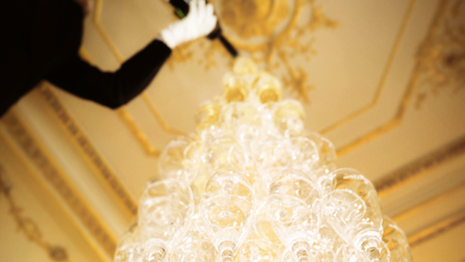
 Luxury still relies on in-person events. Image credit: Moët & Chandon
Luxury still relies on in-person events. Image credit: Moët & Chandon